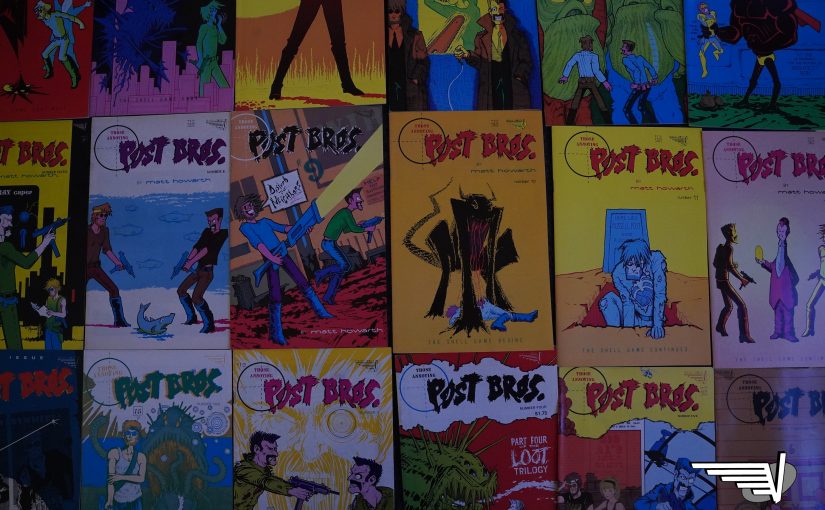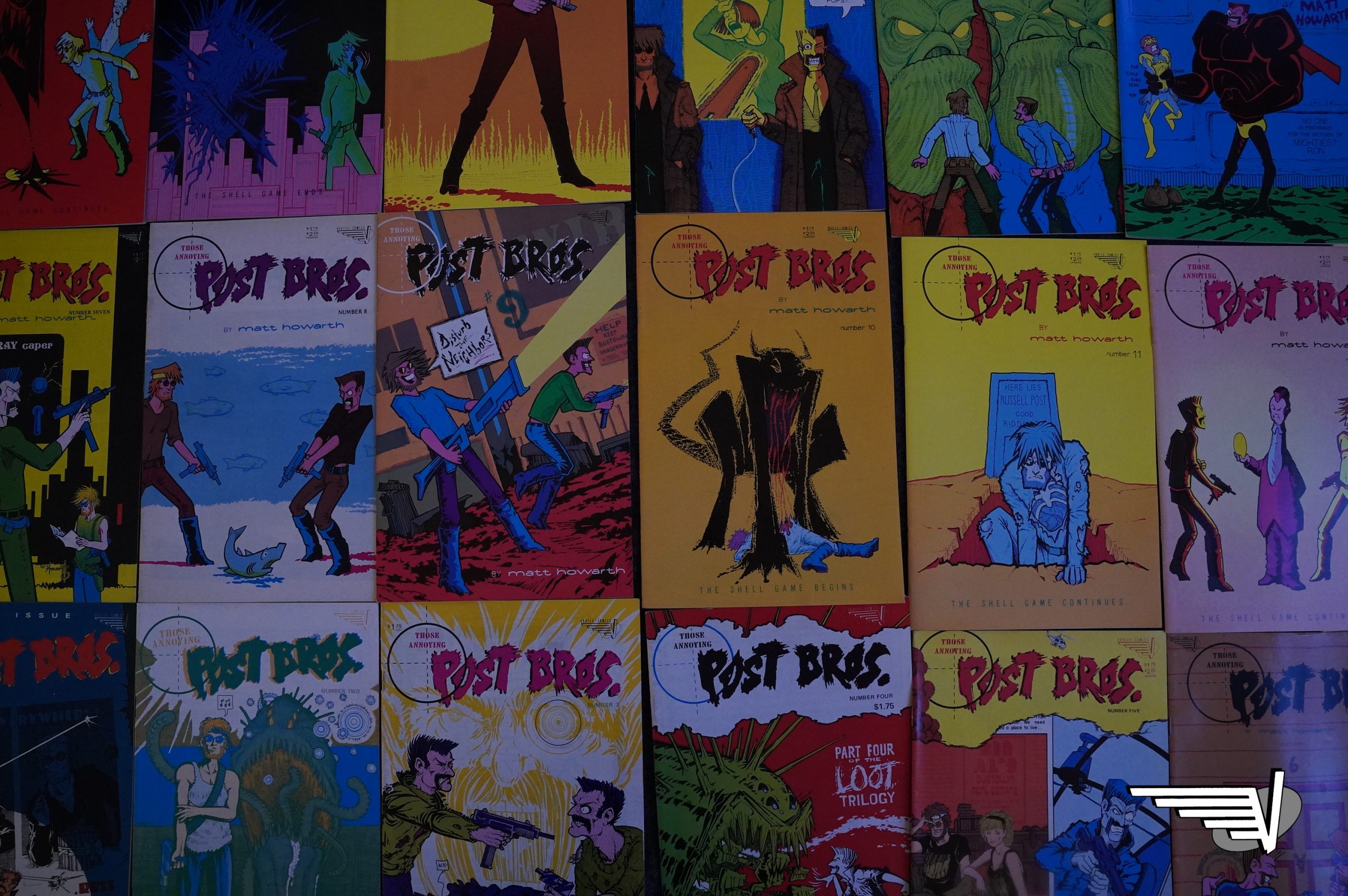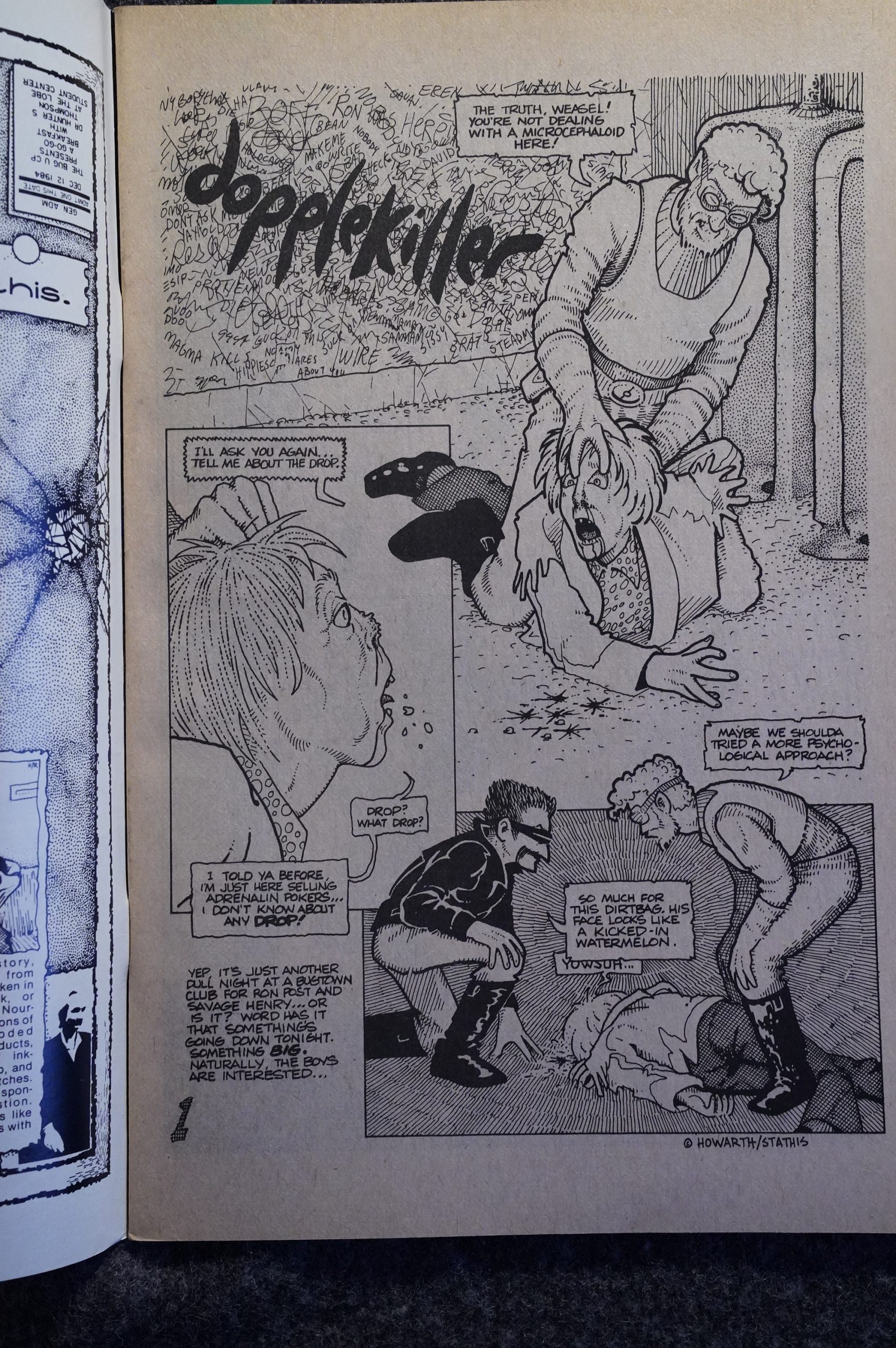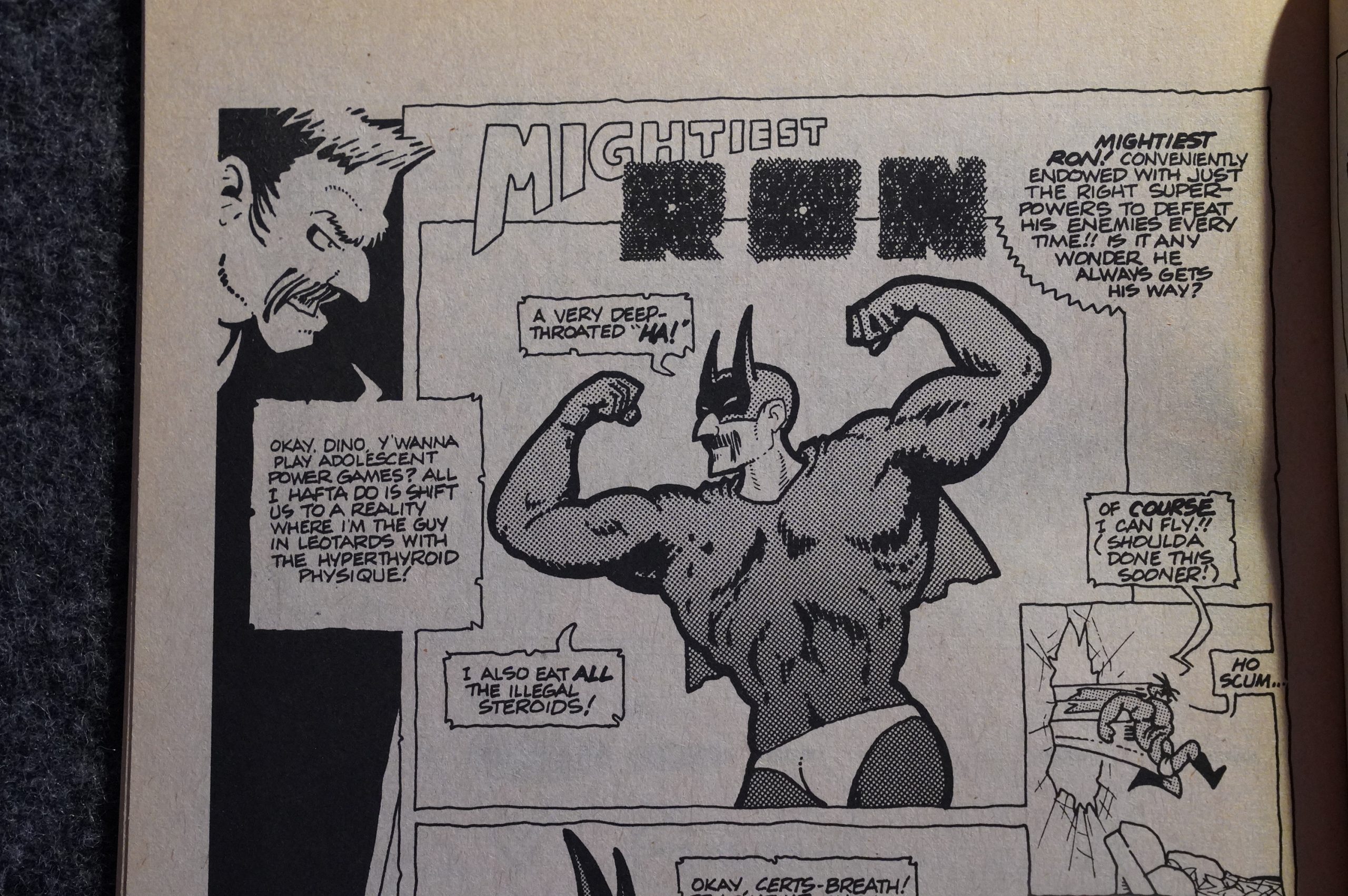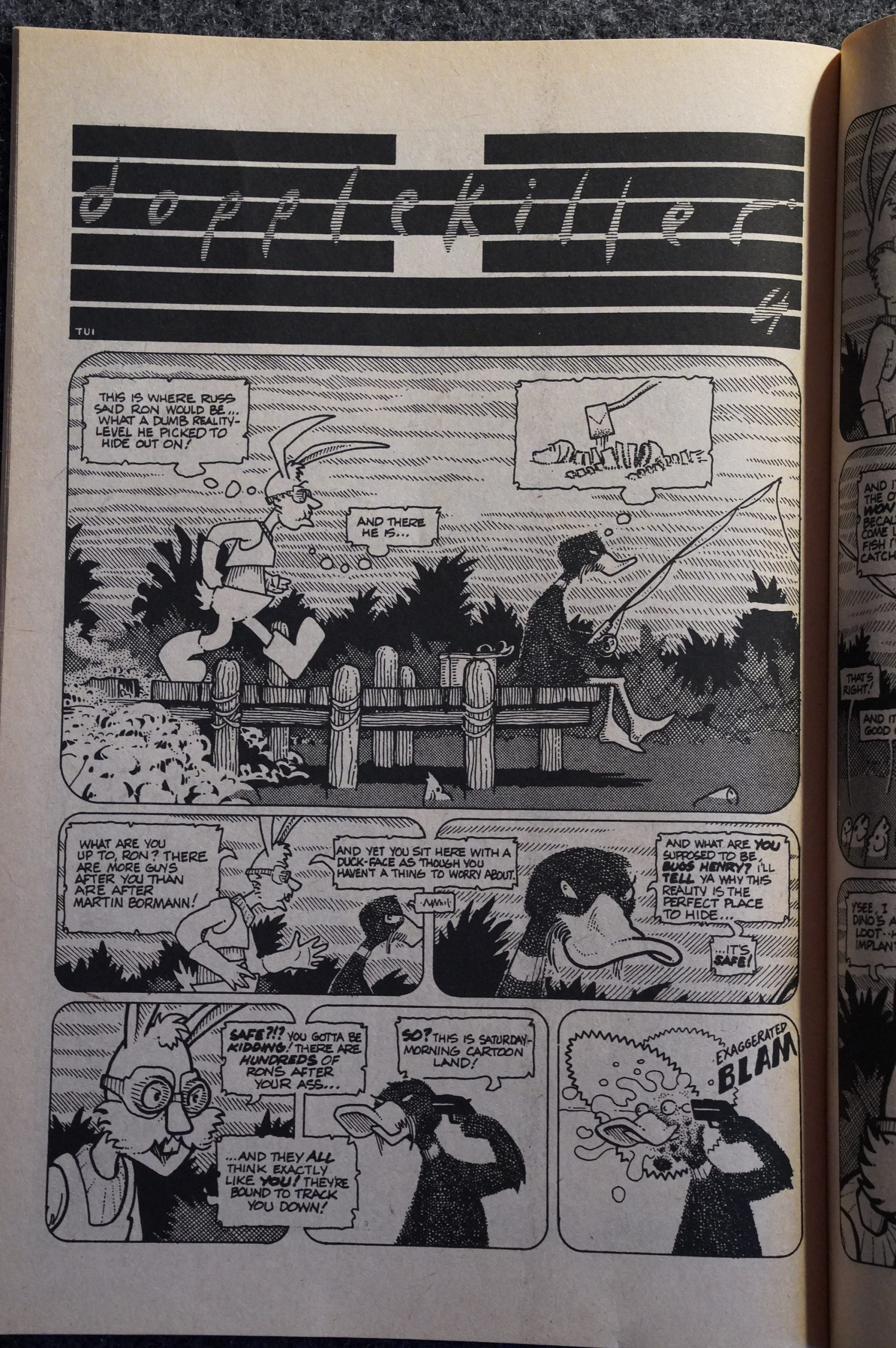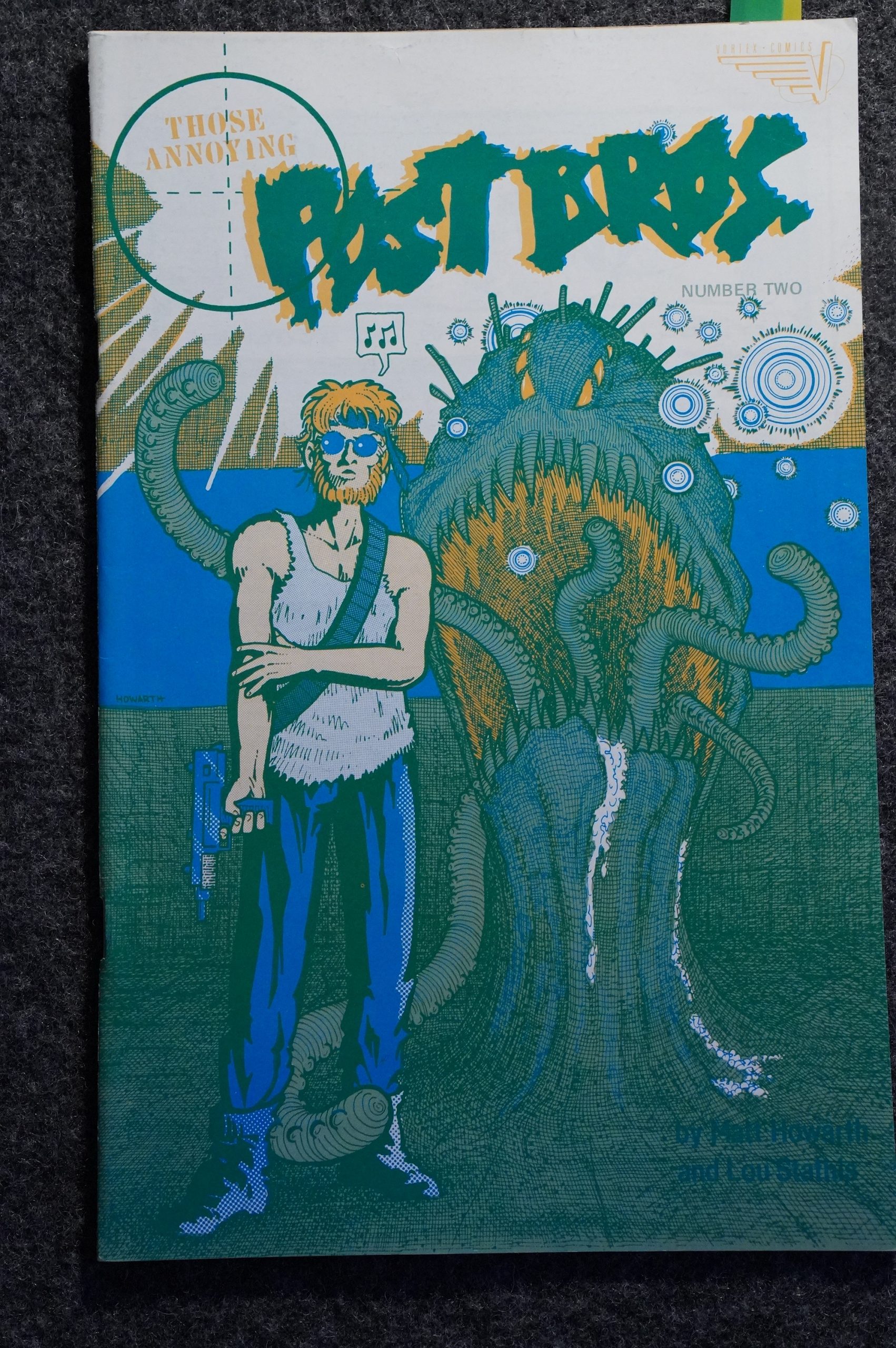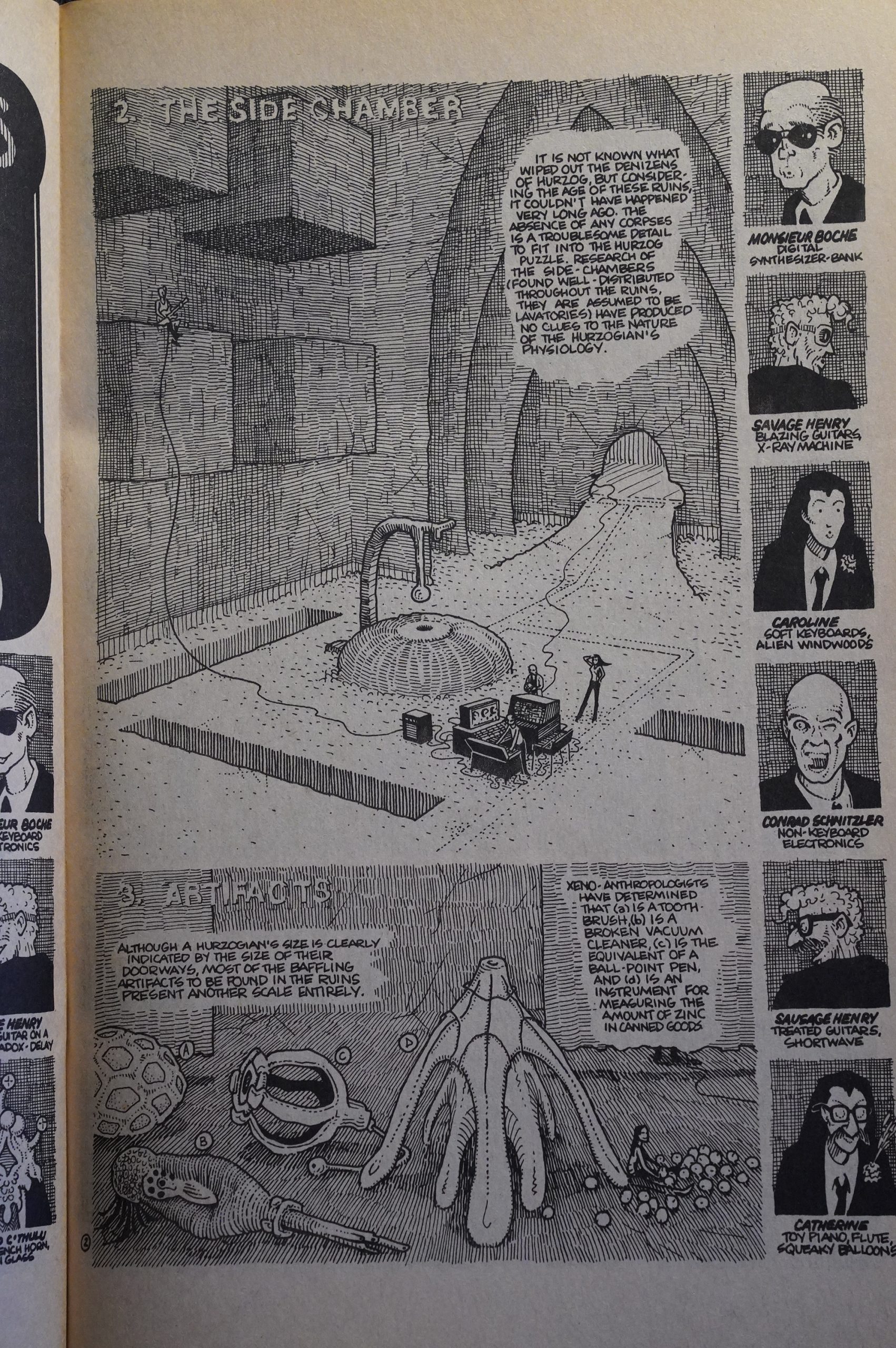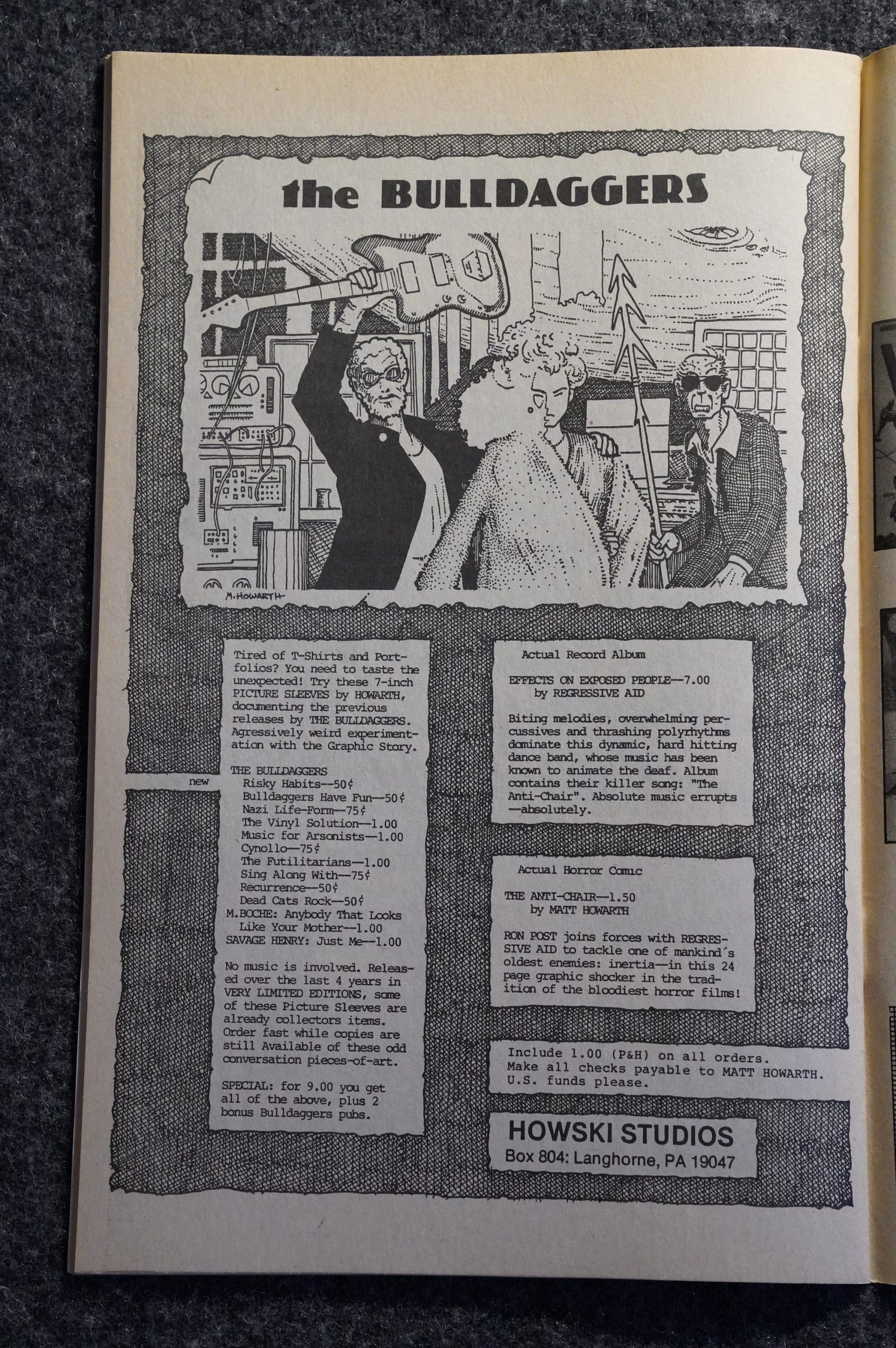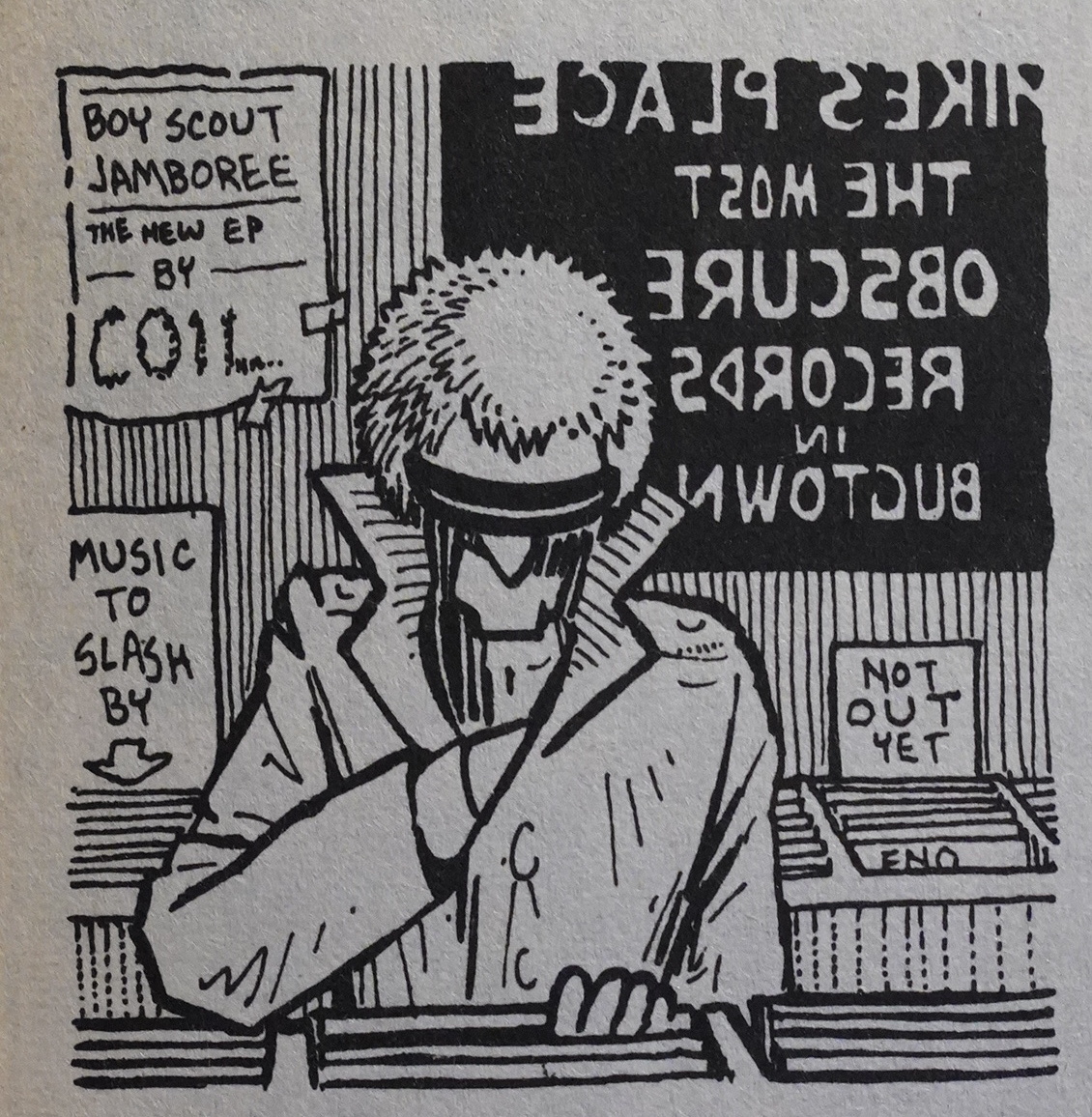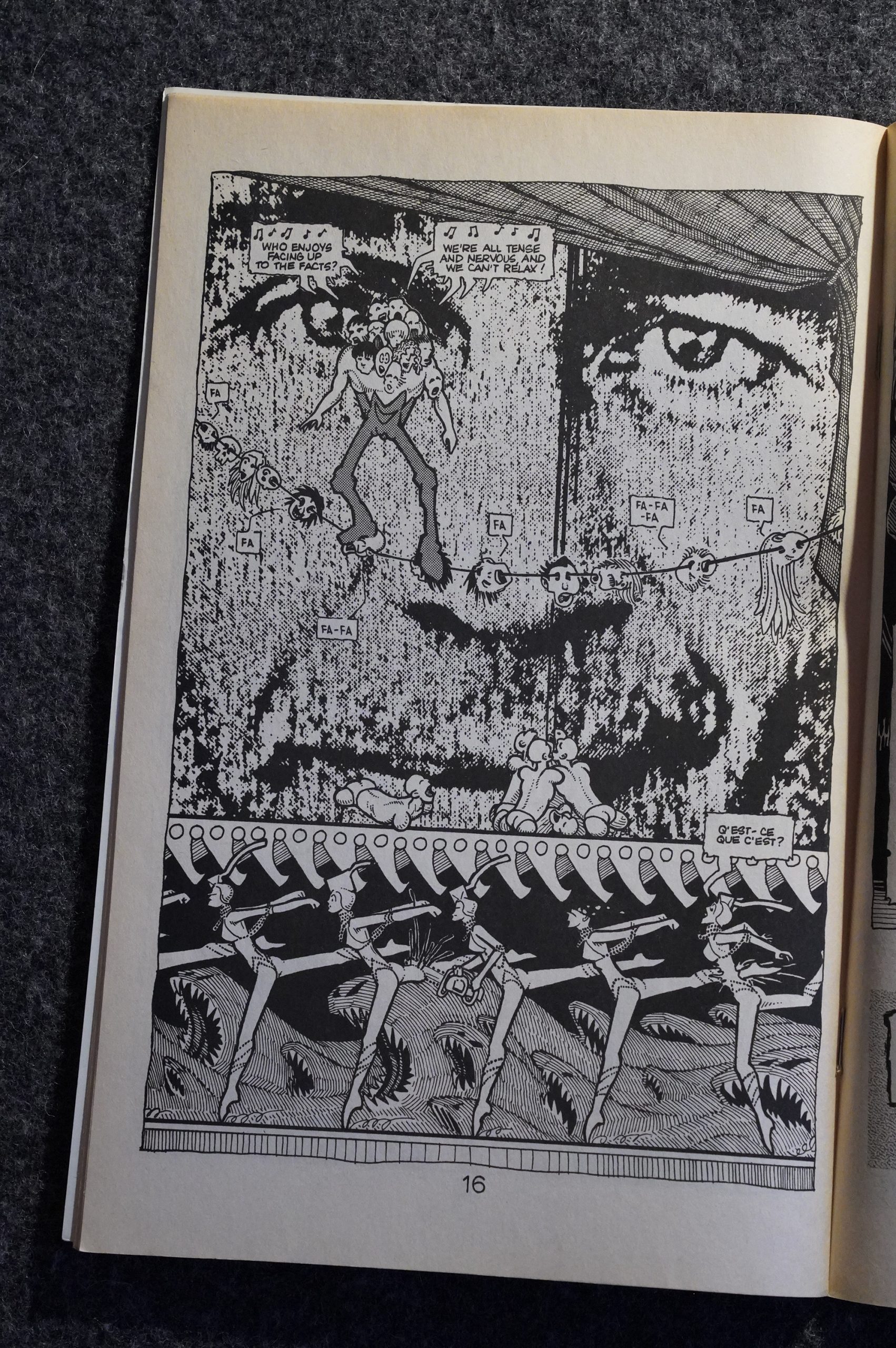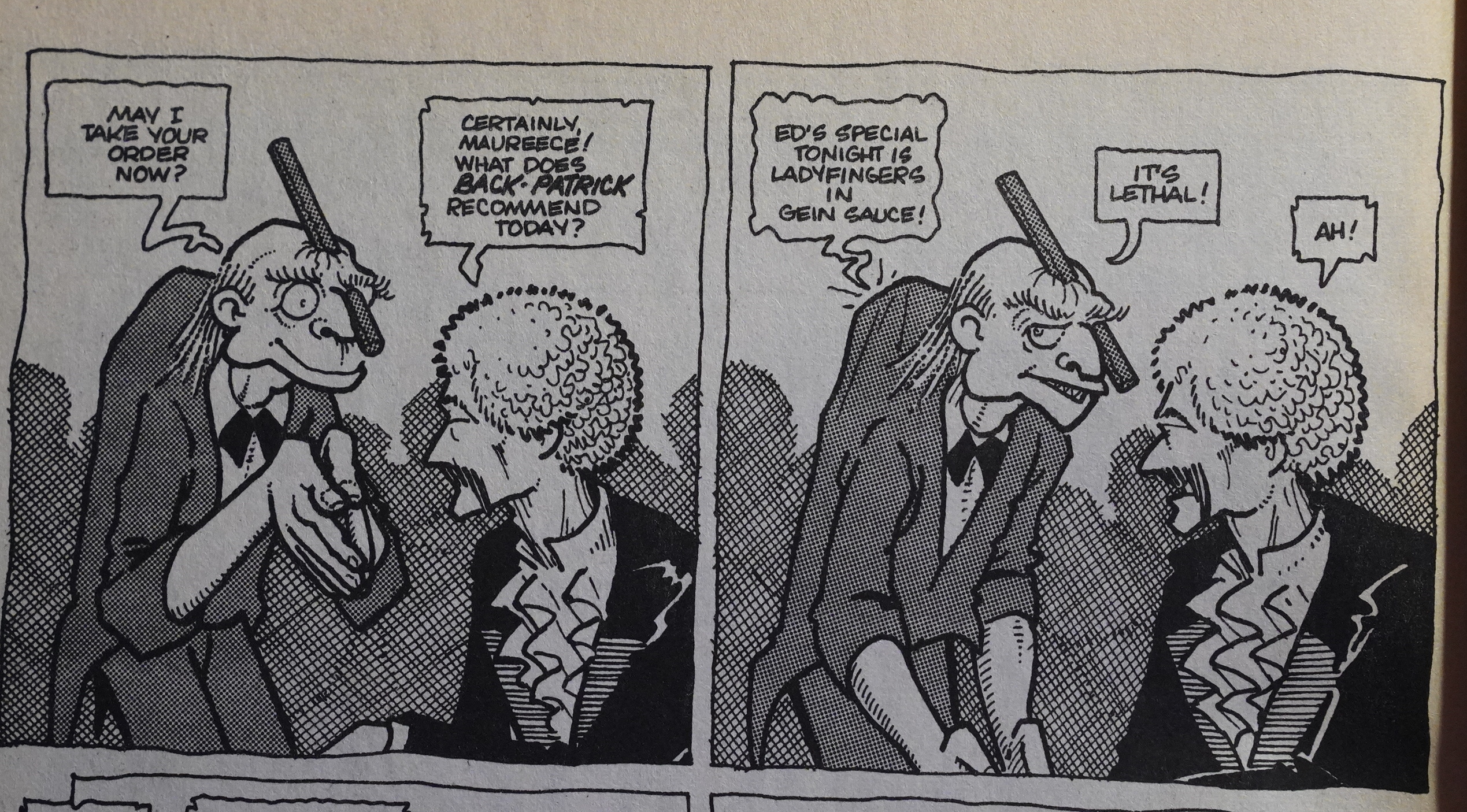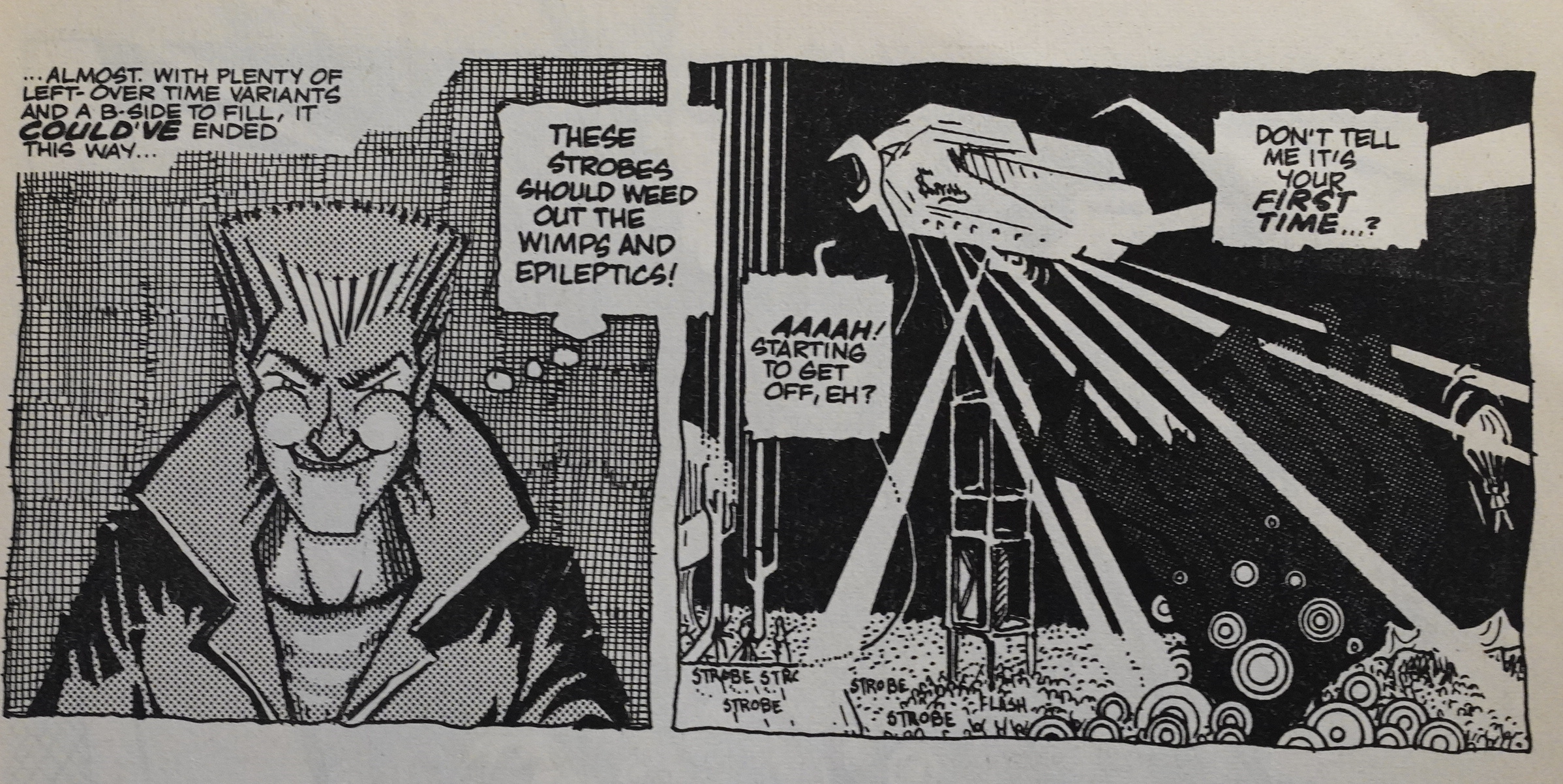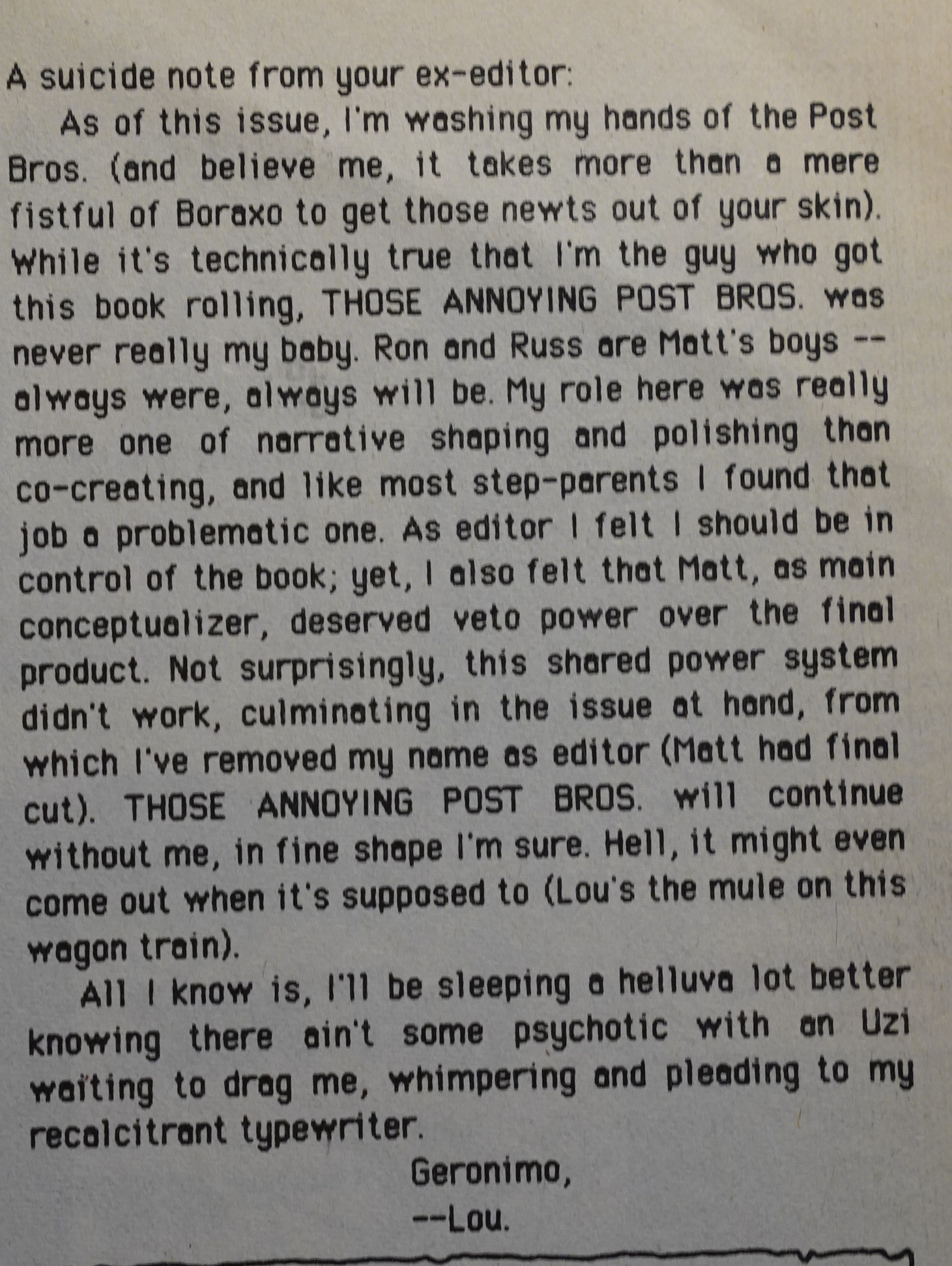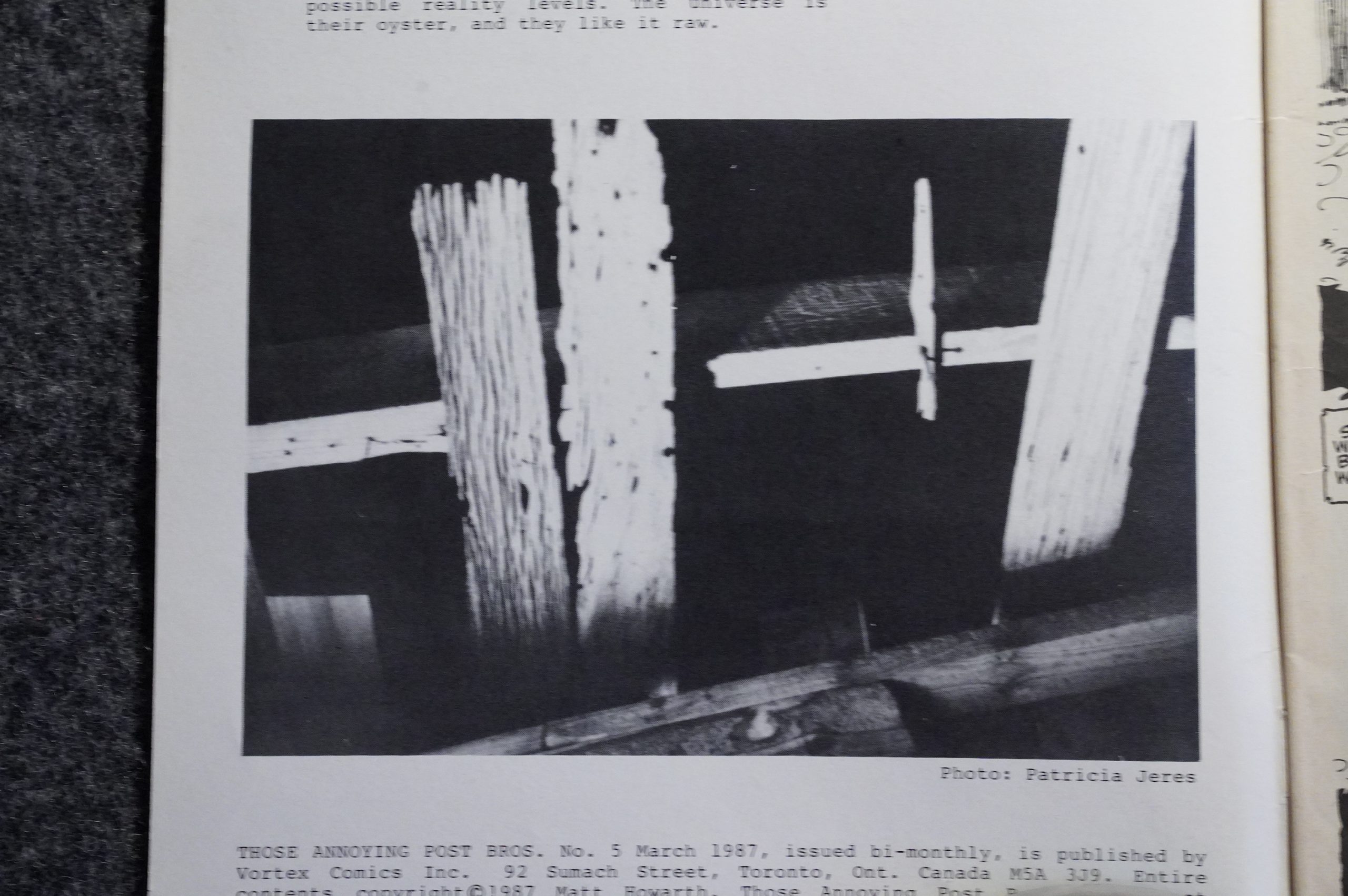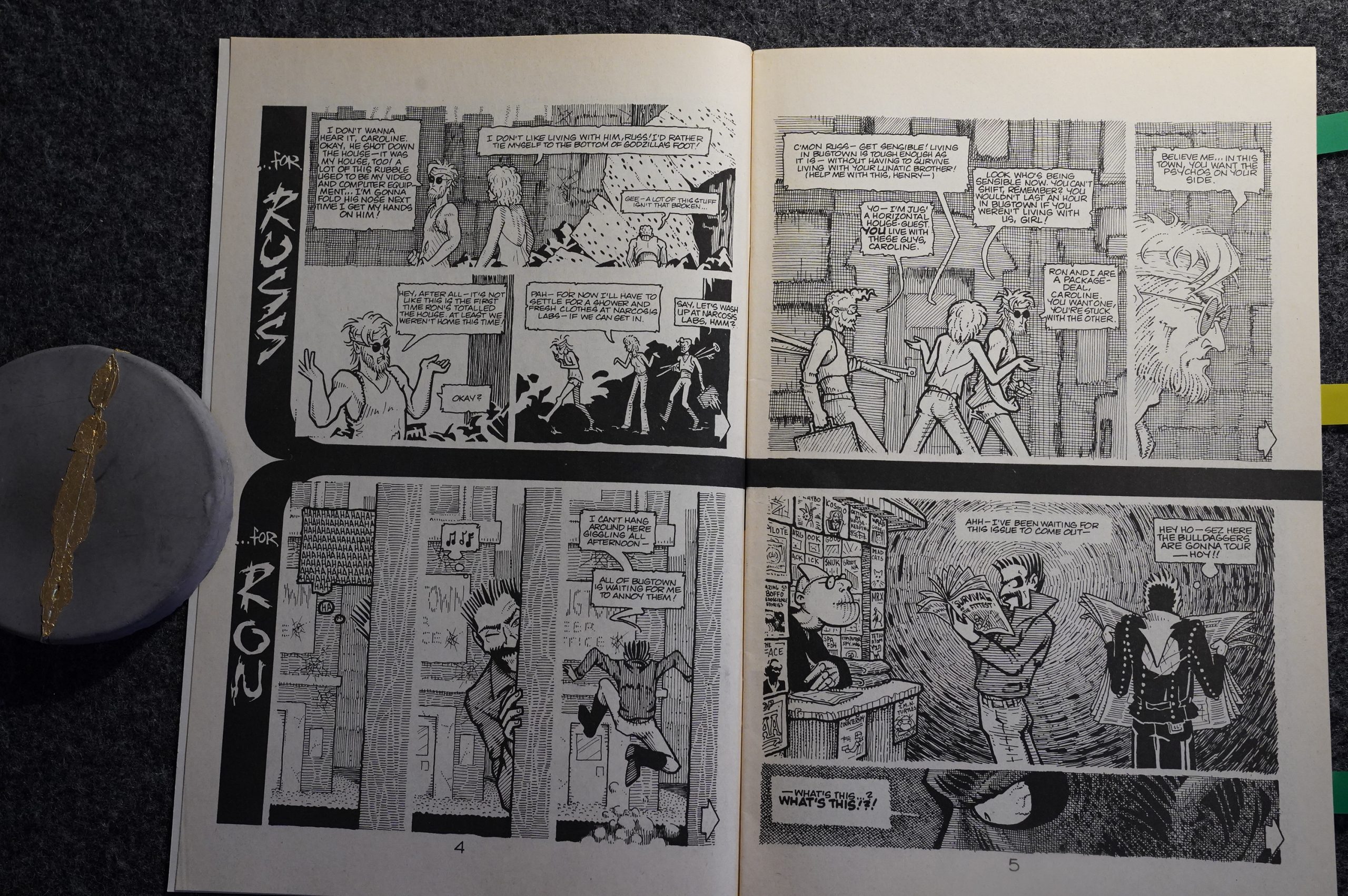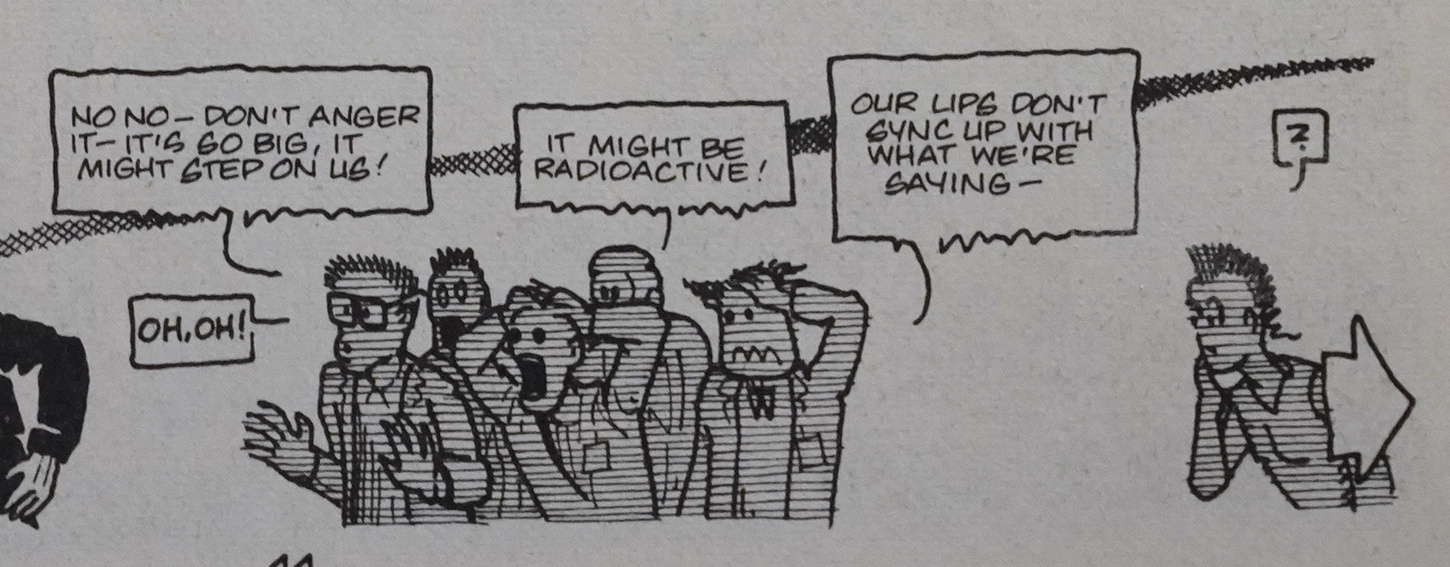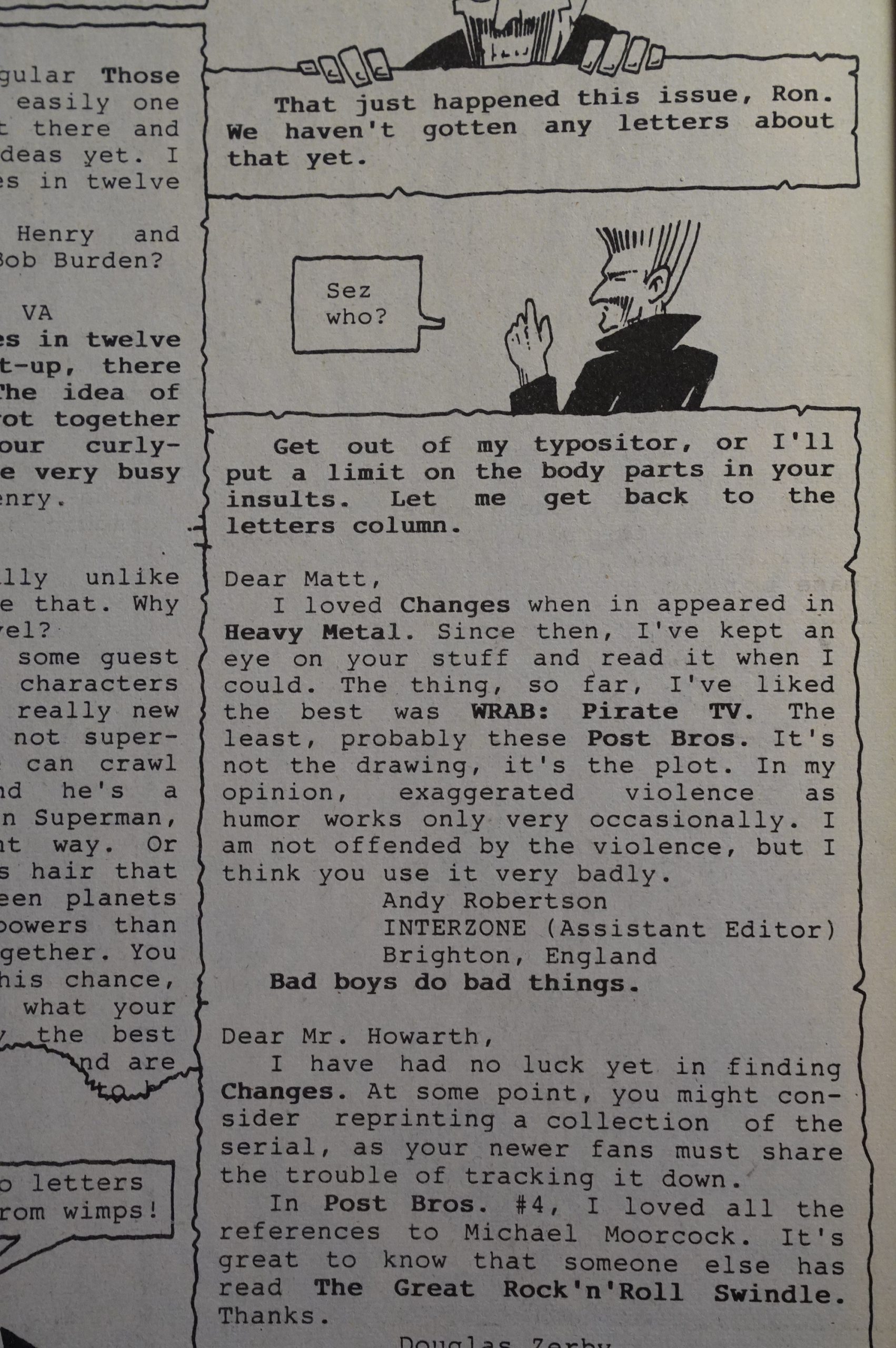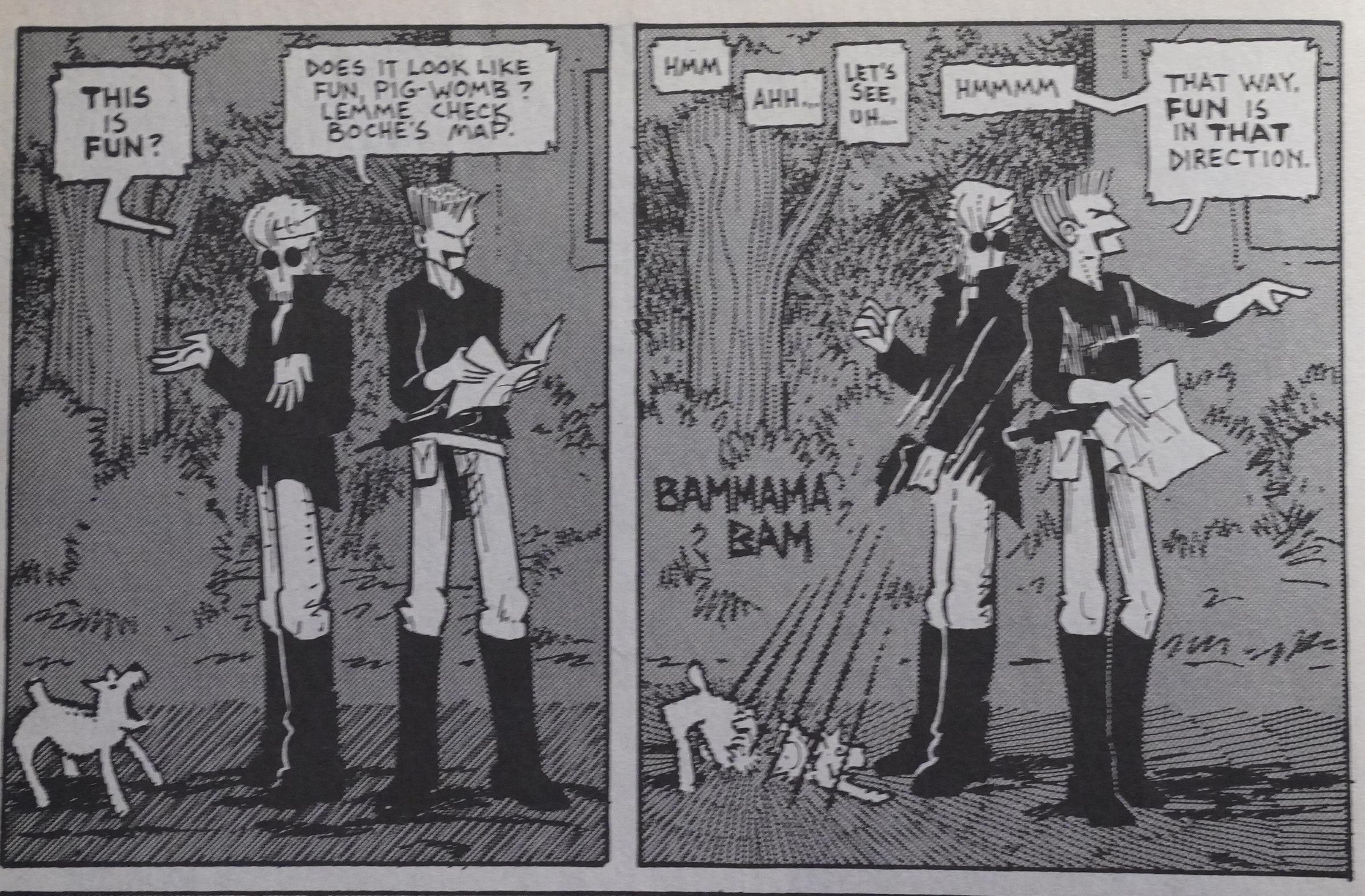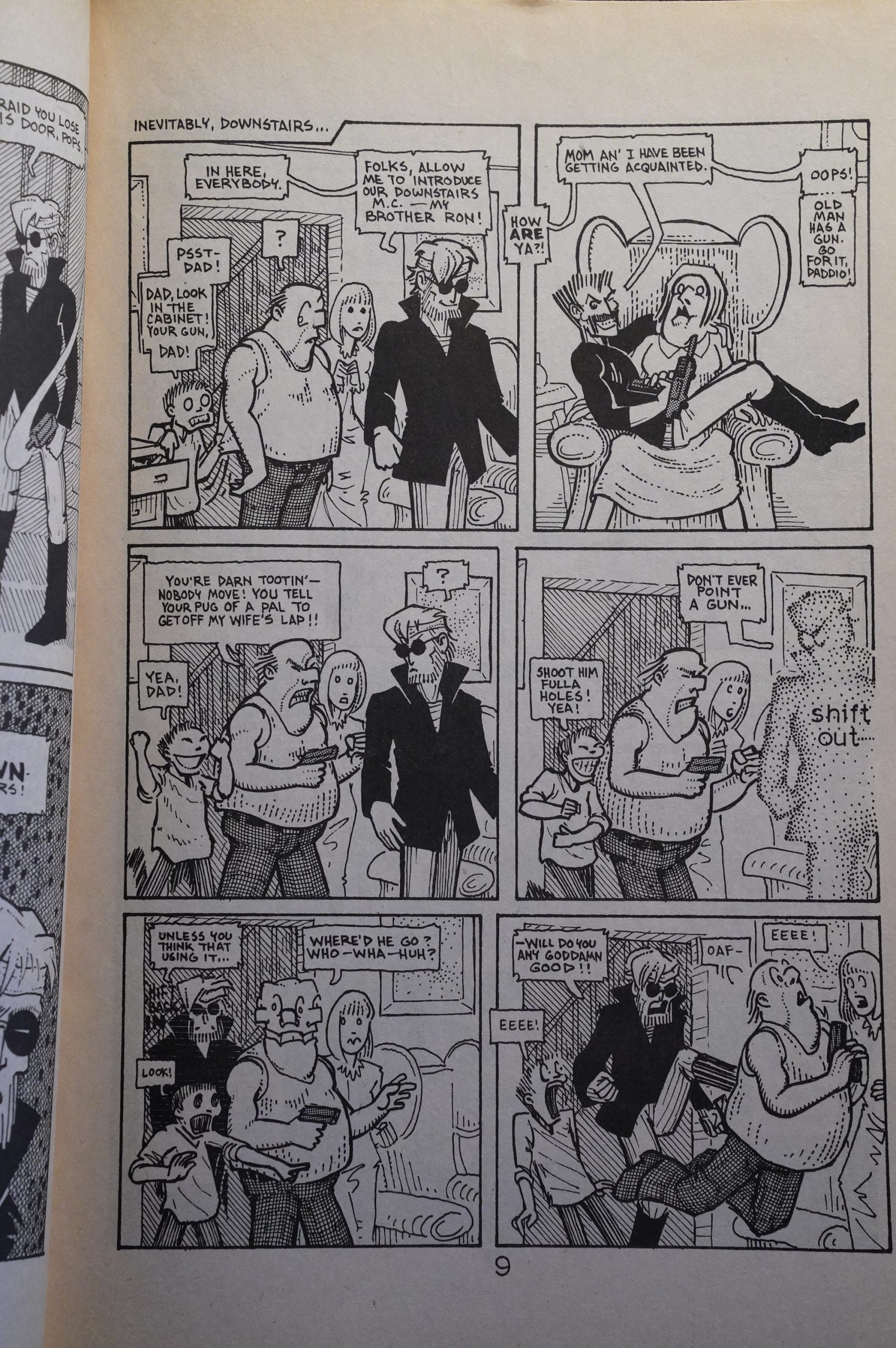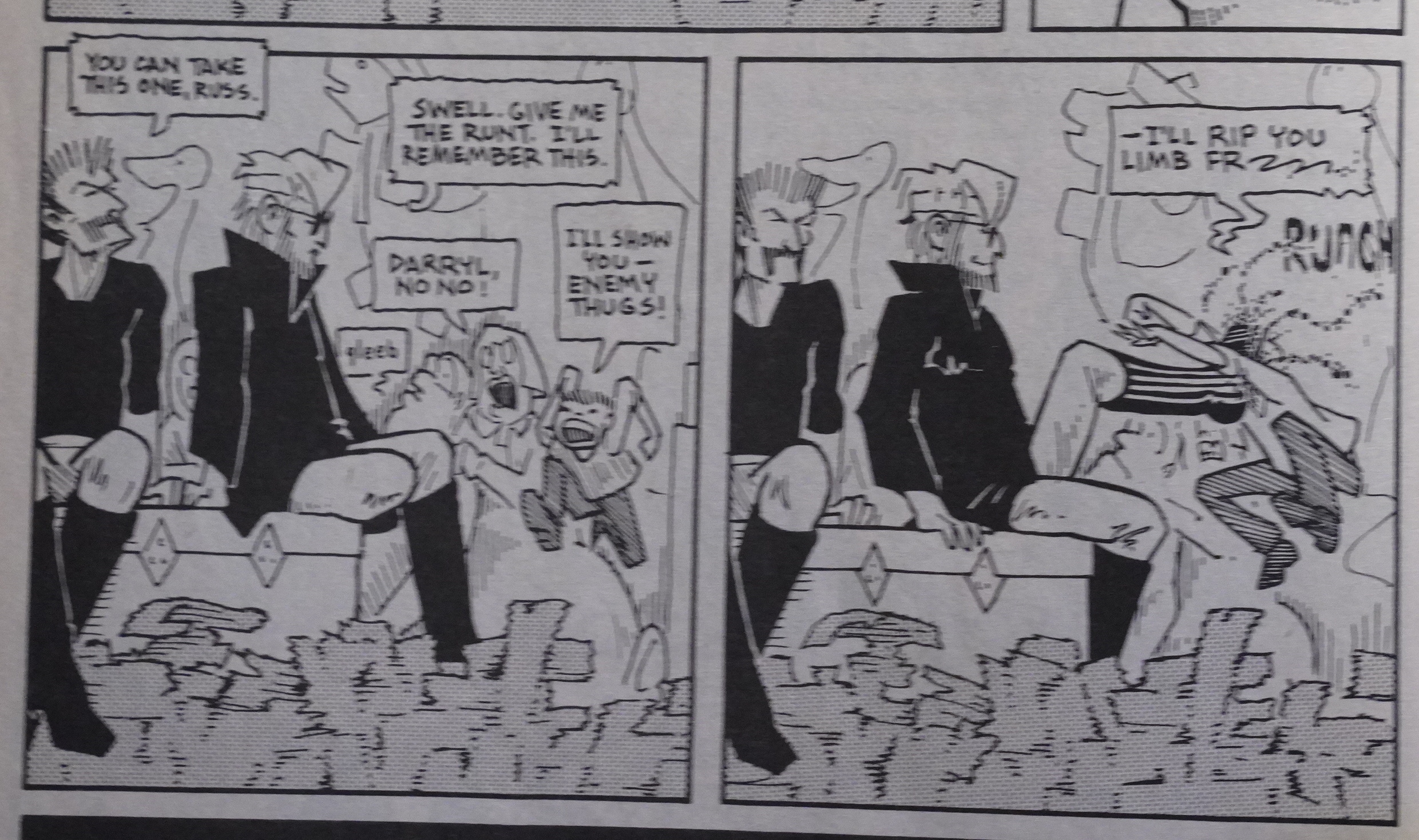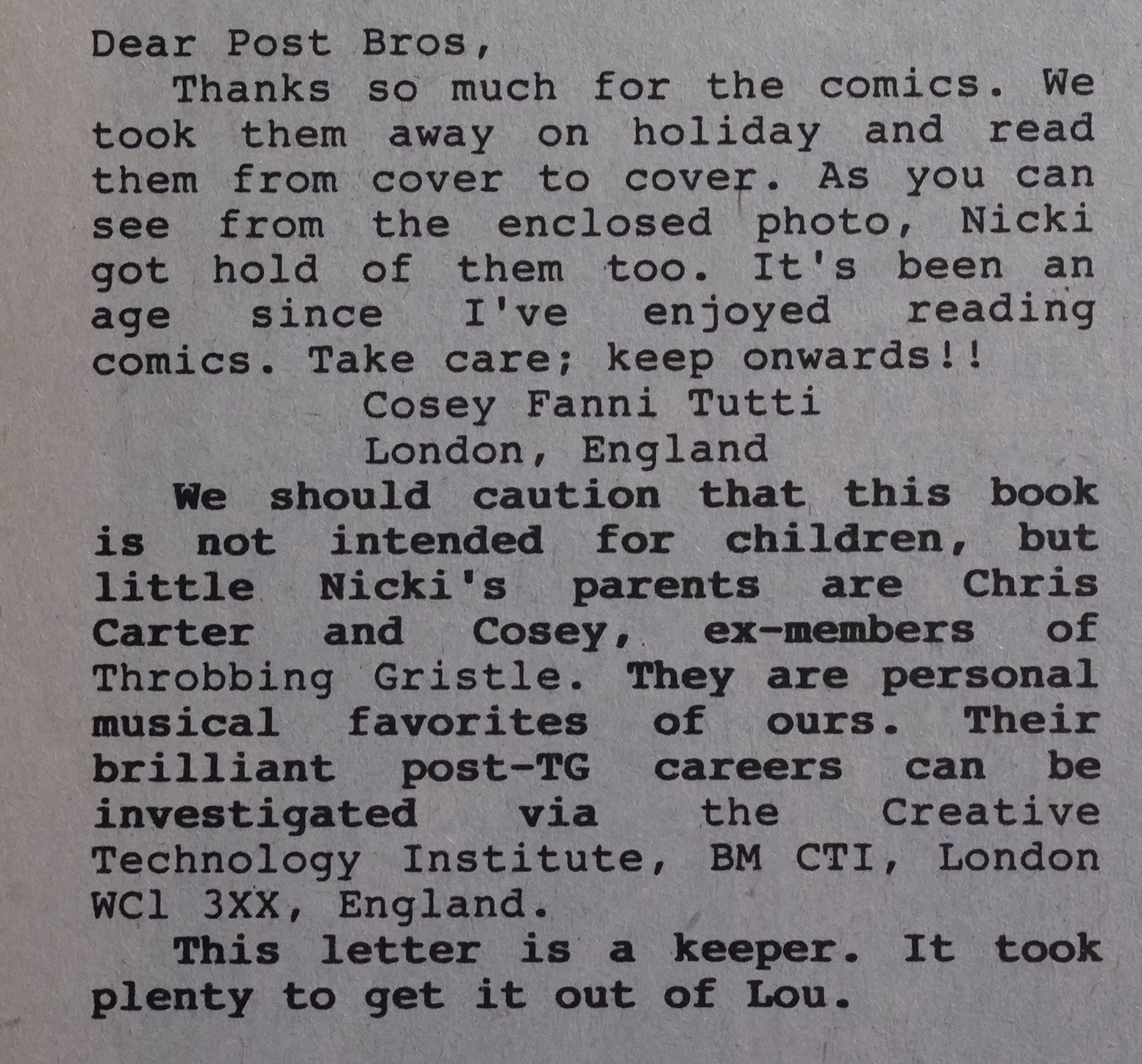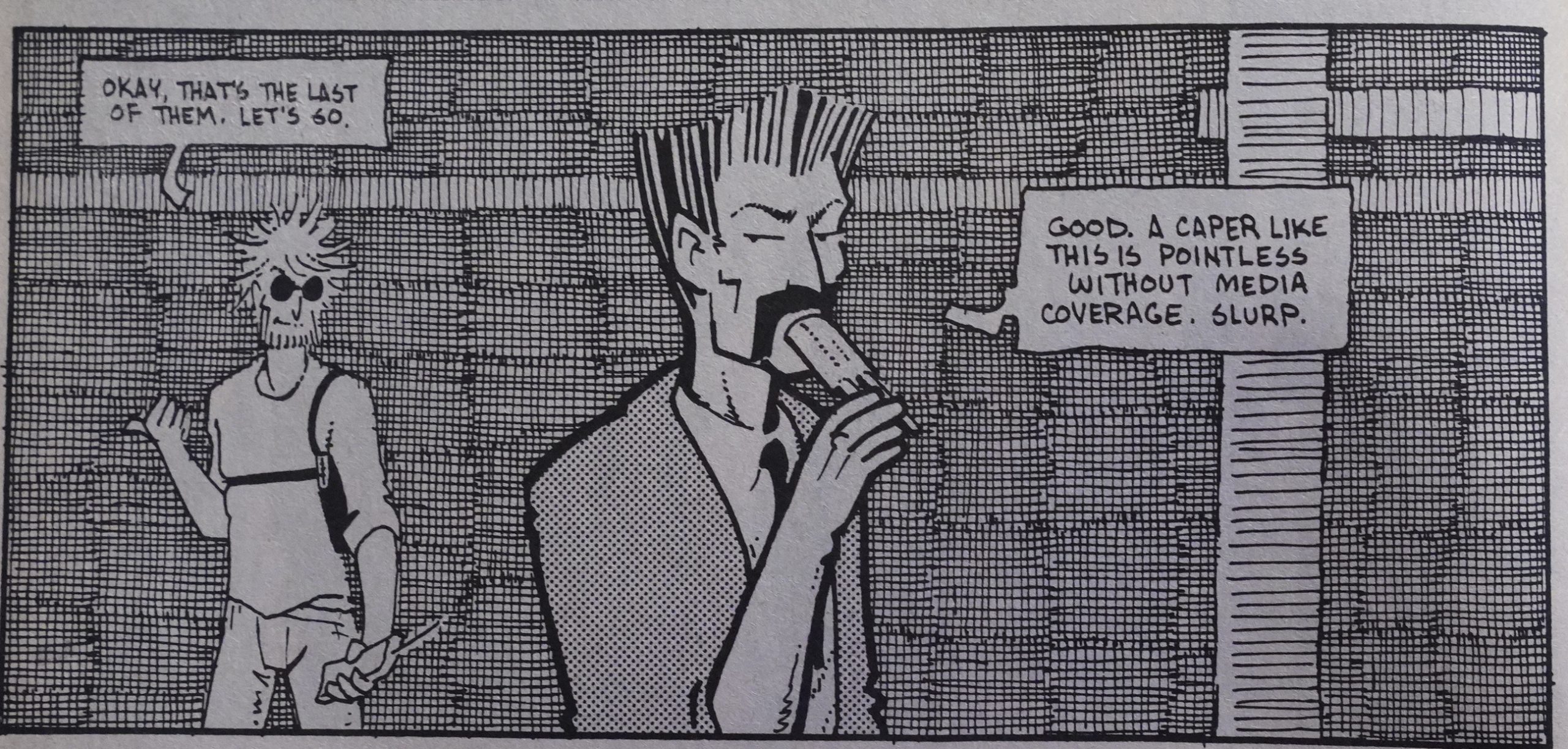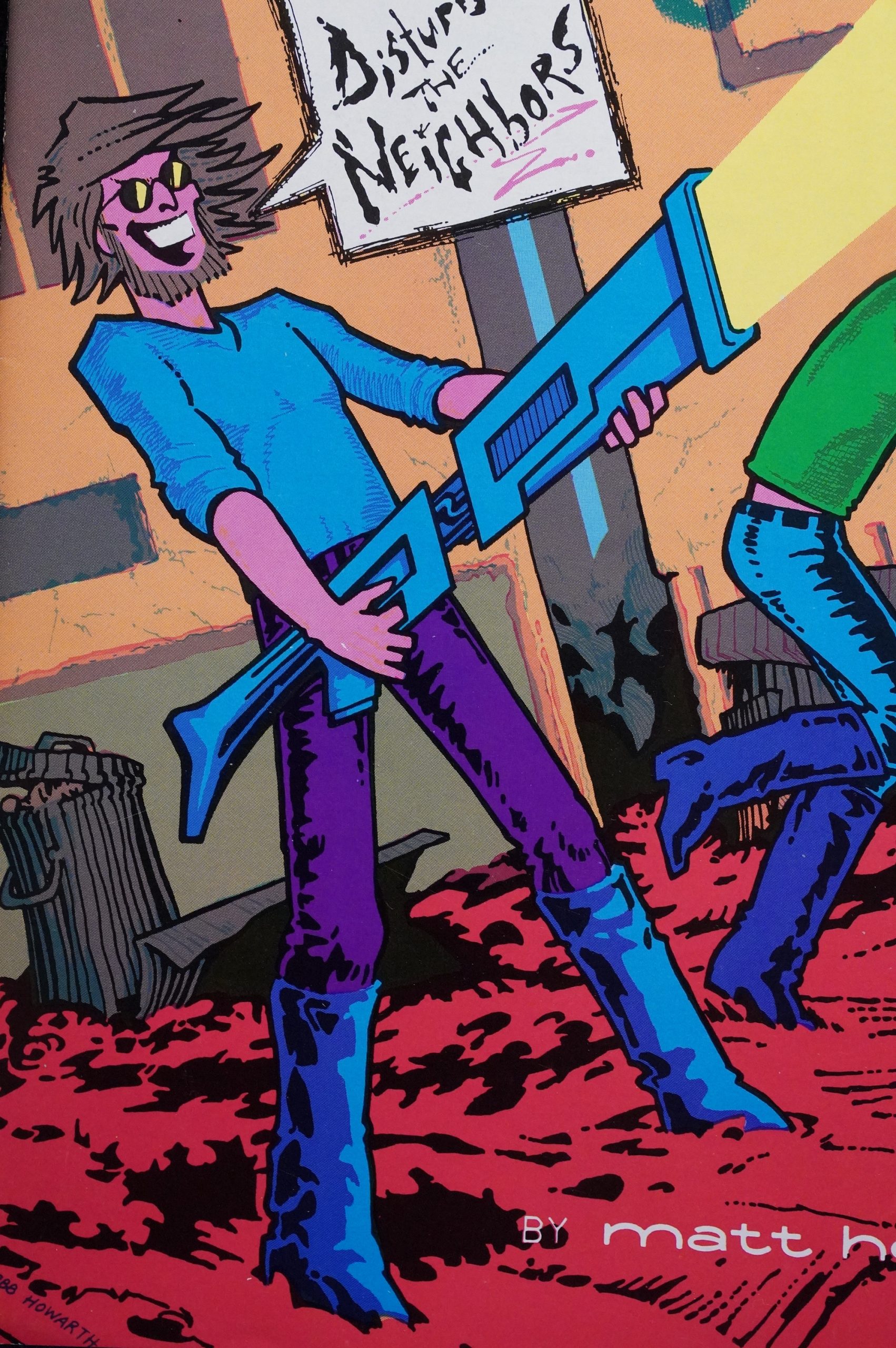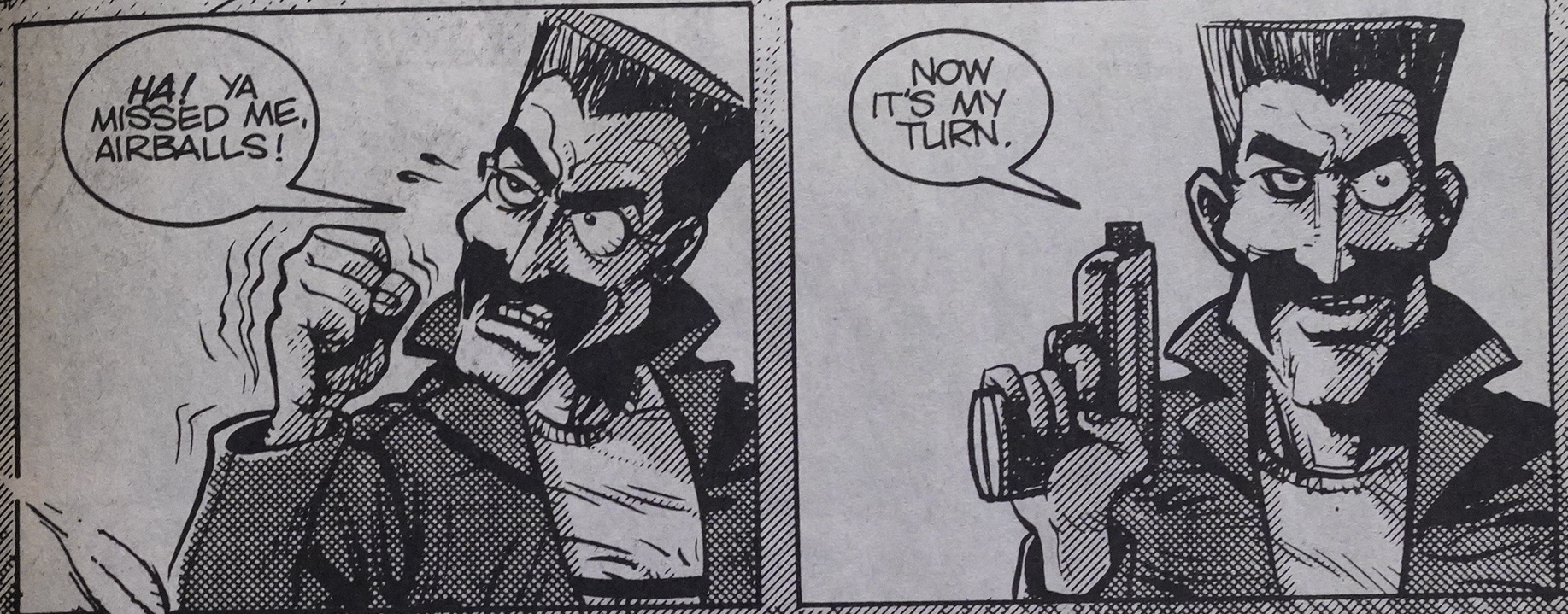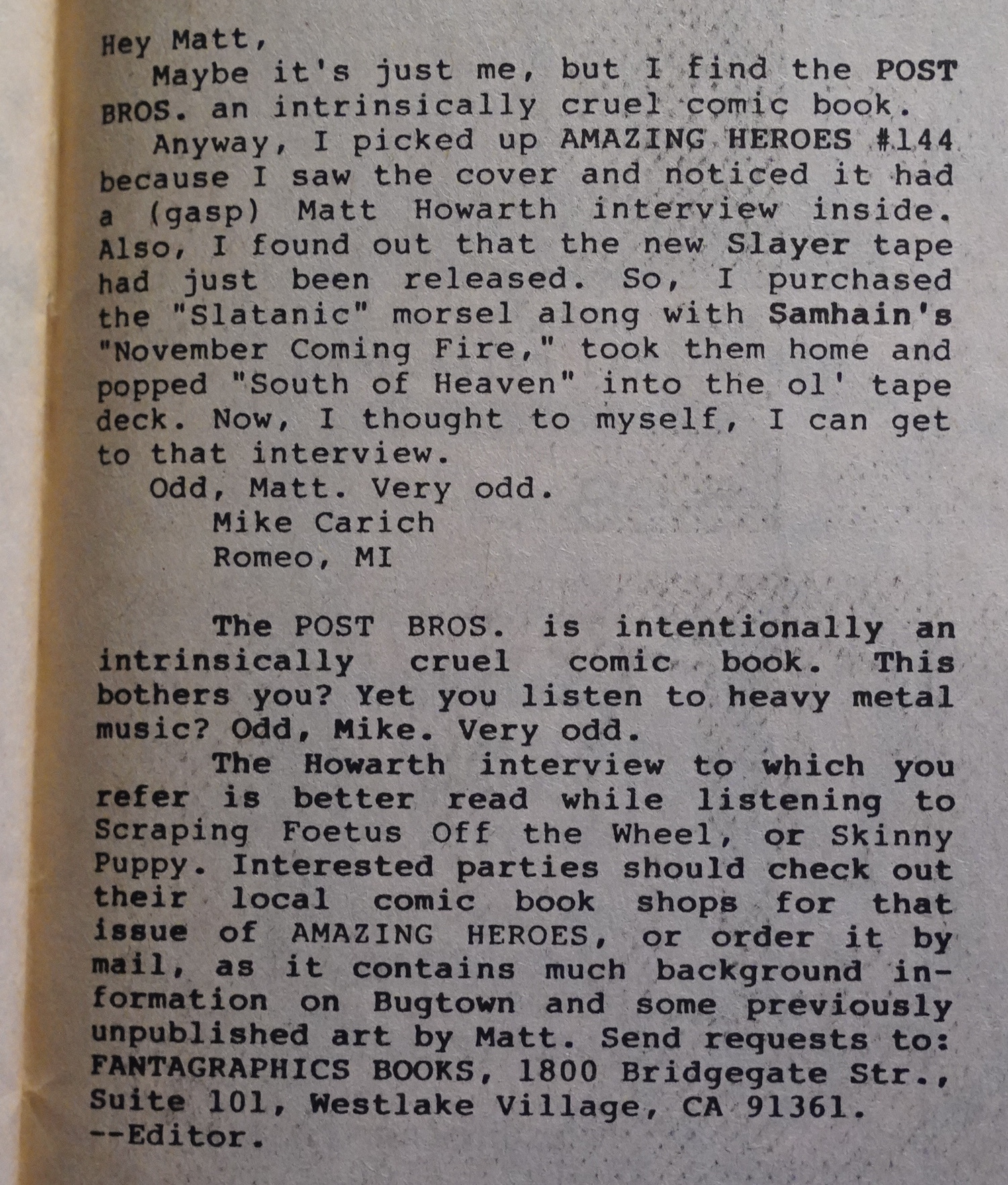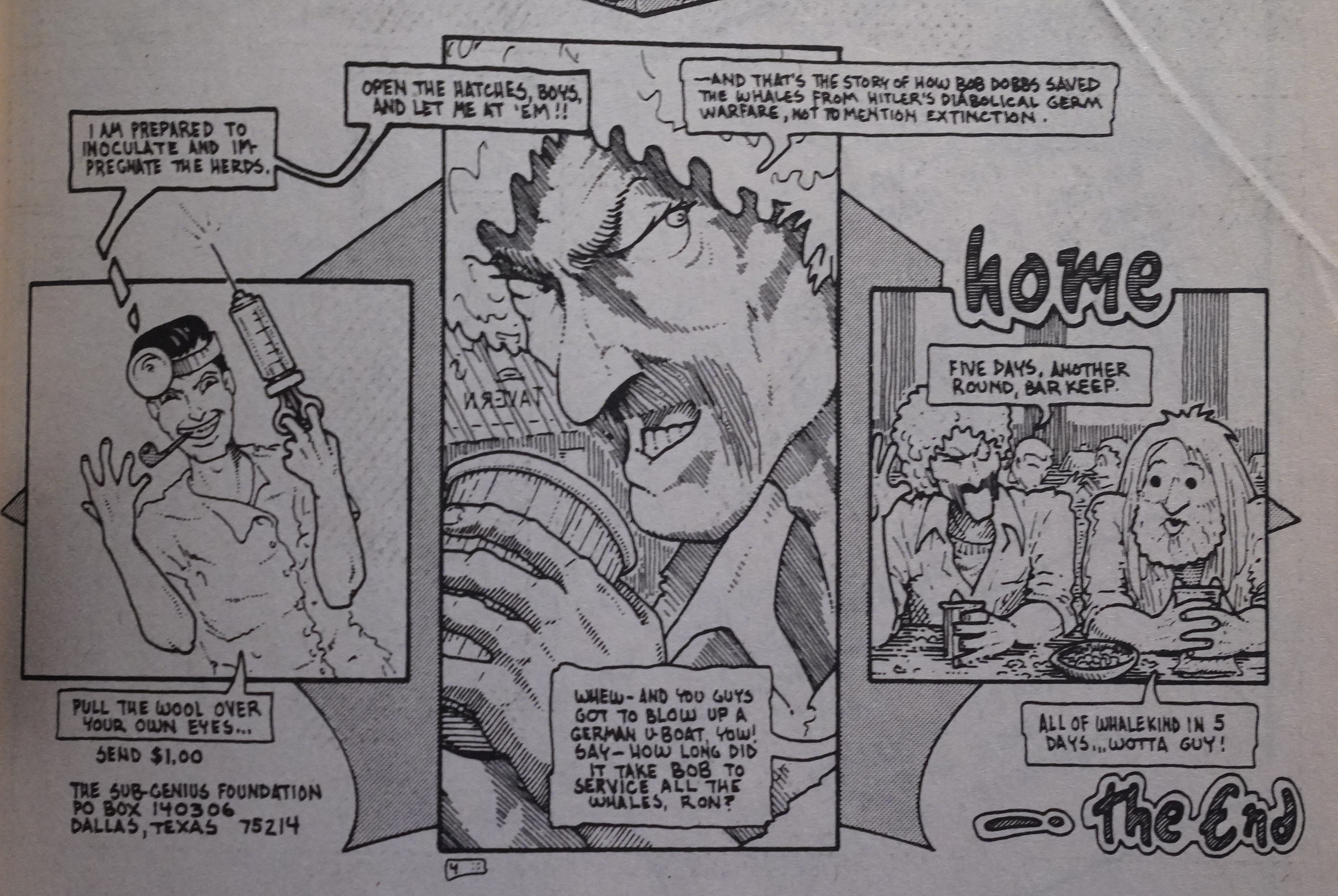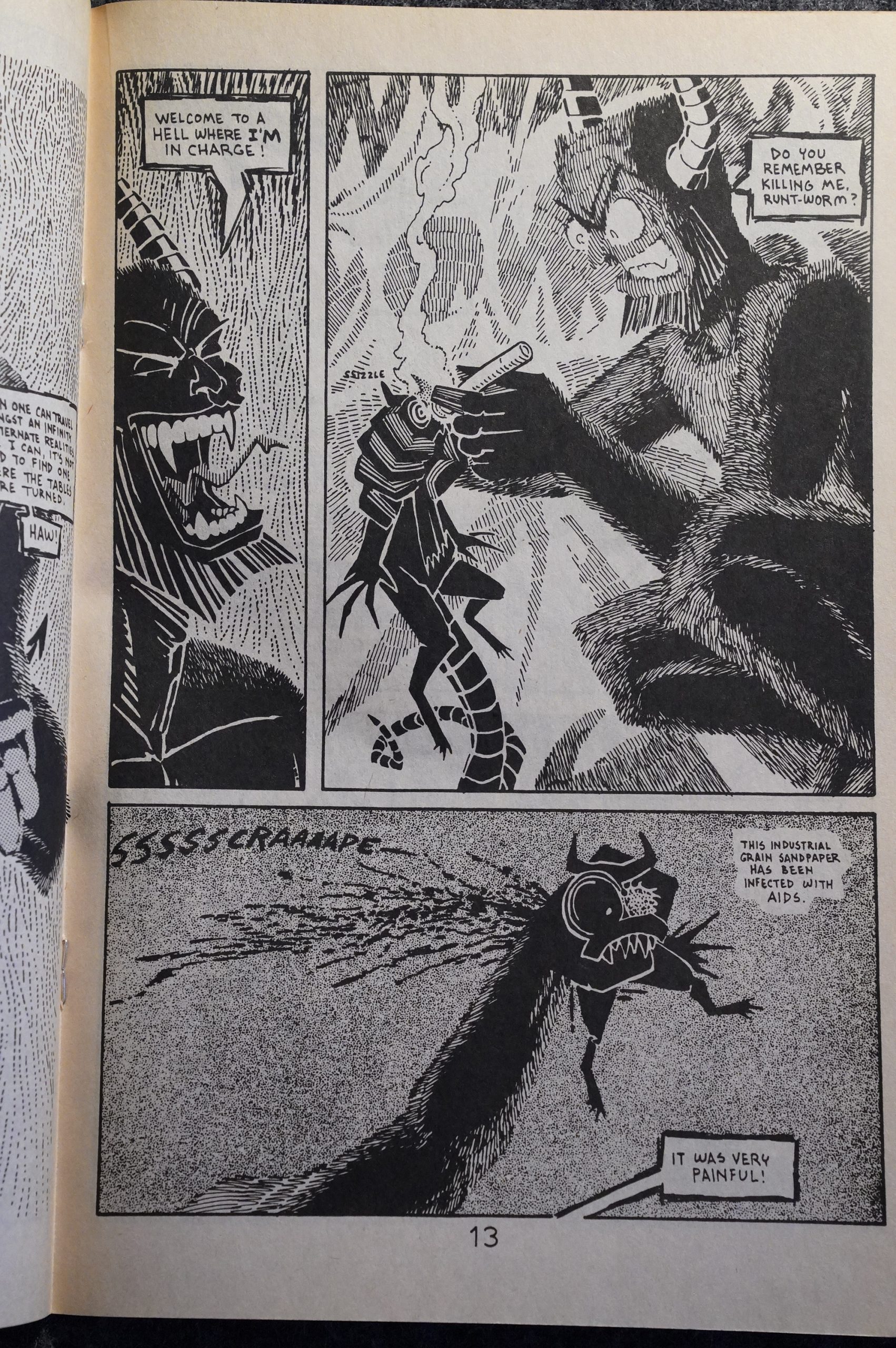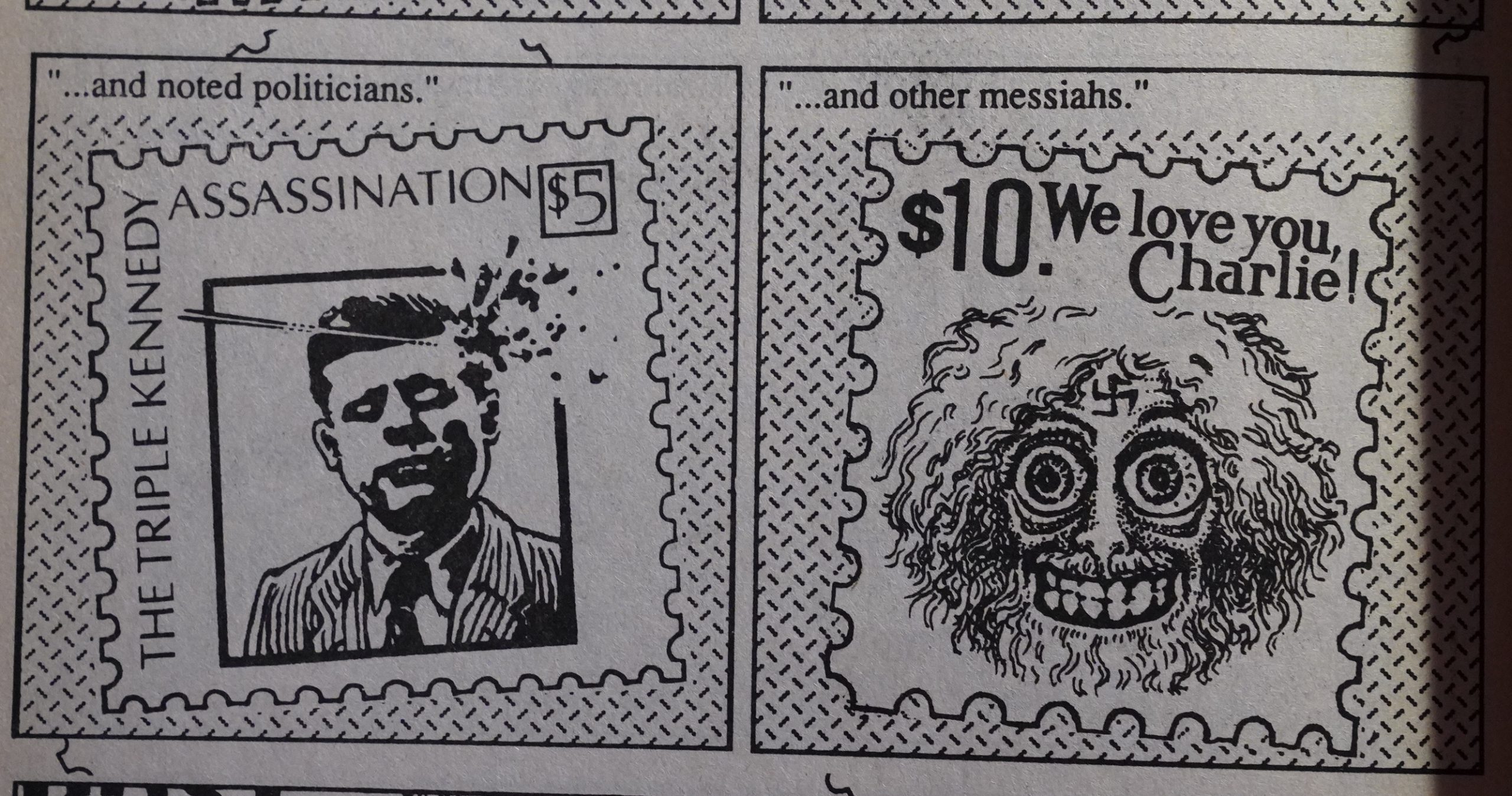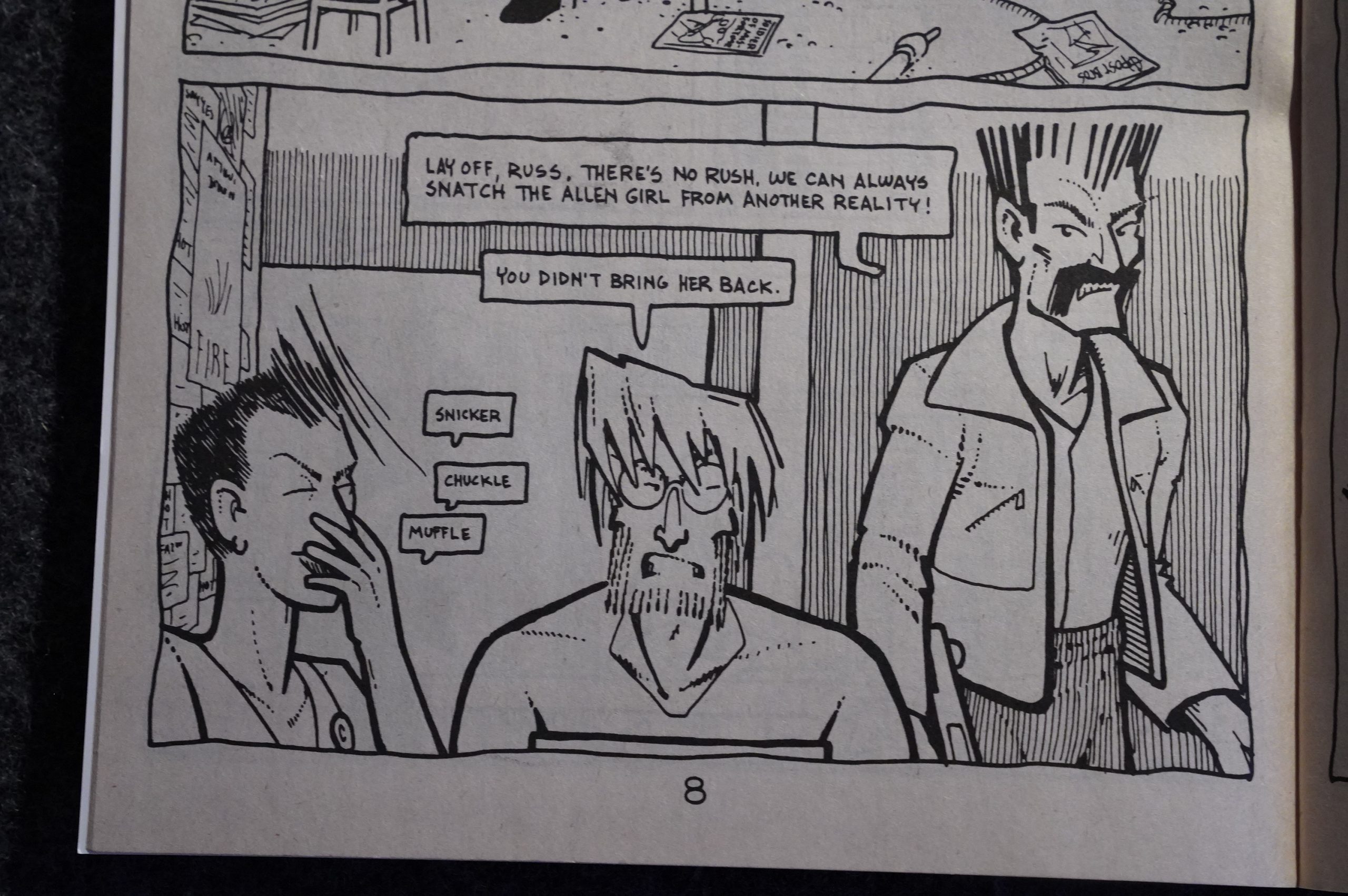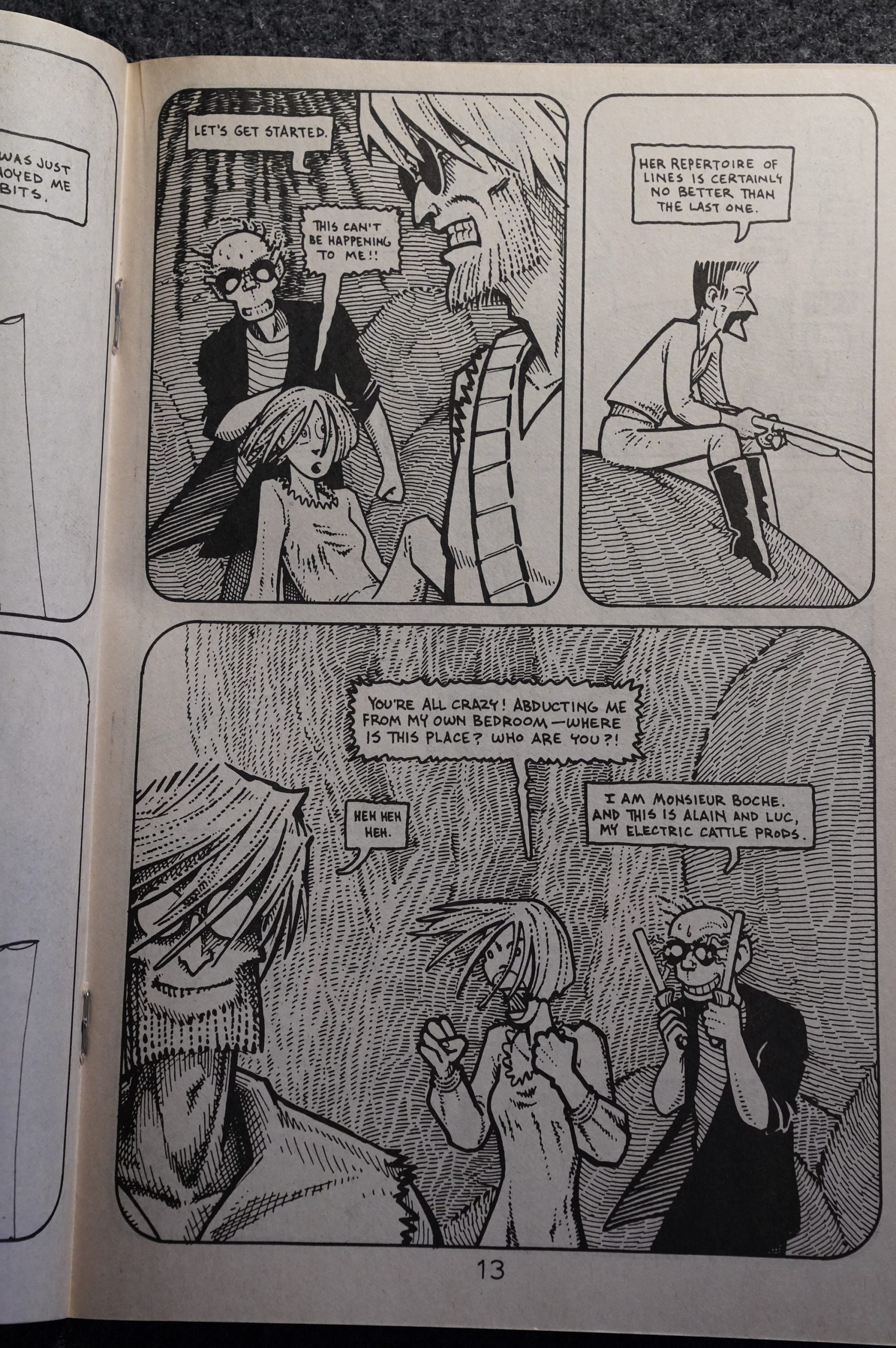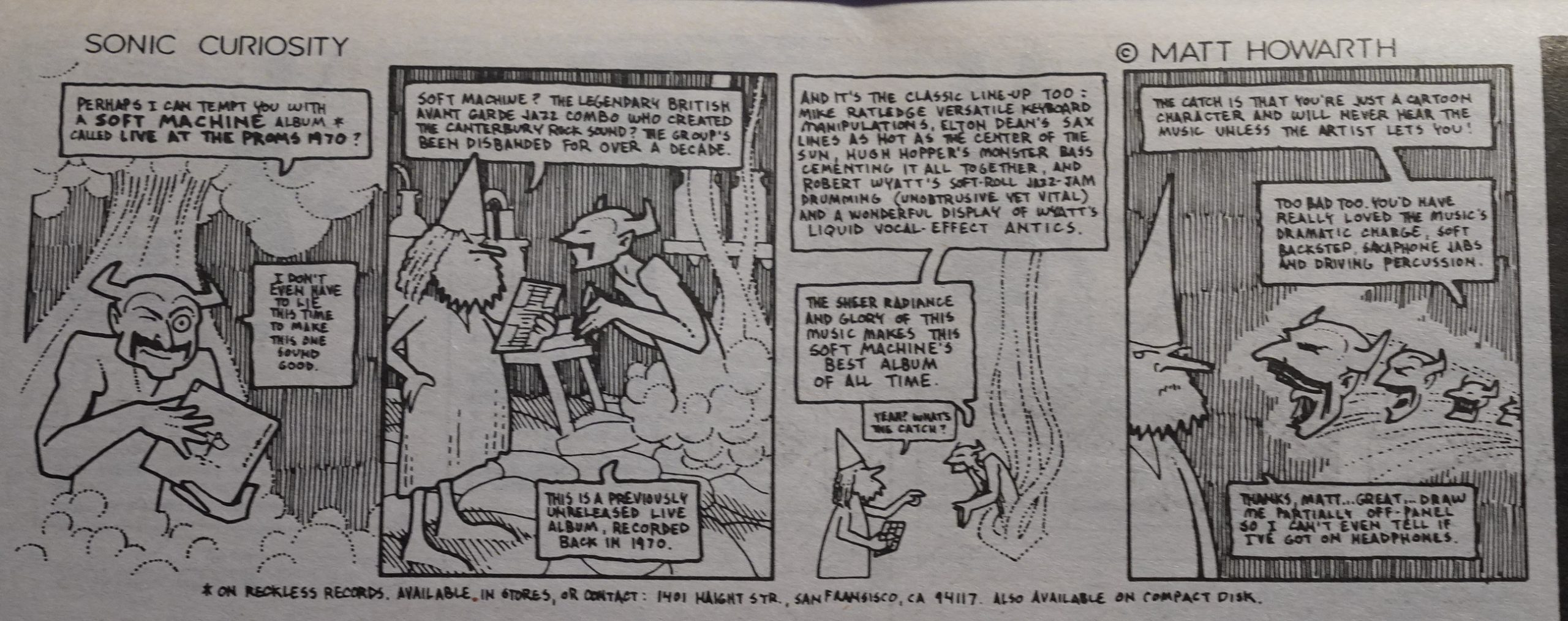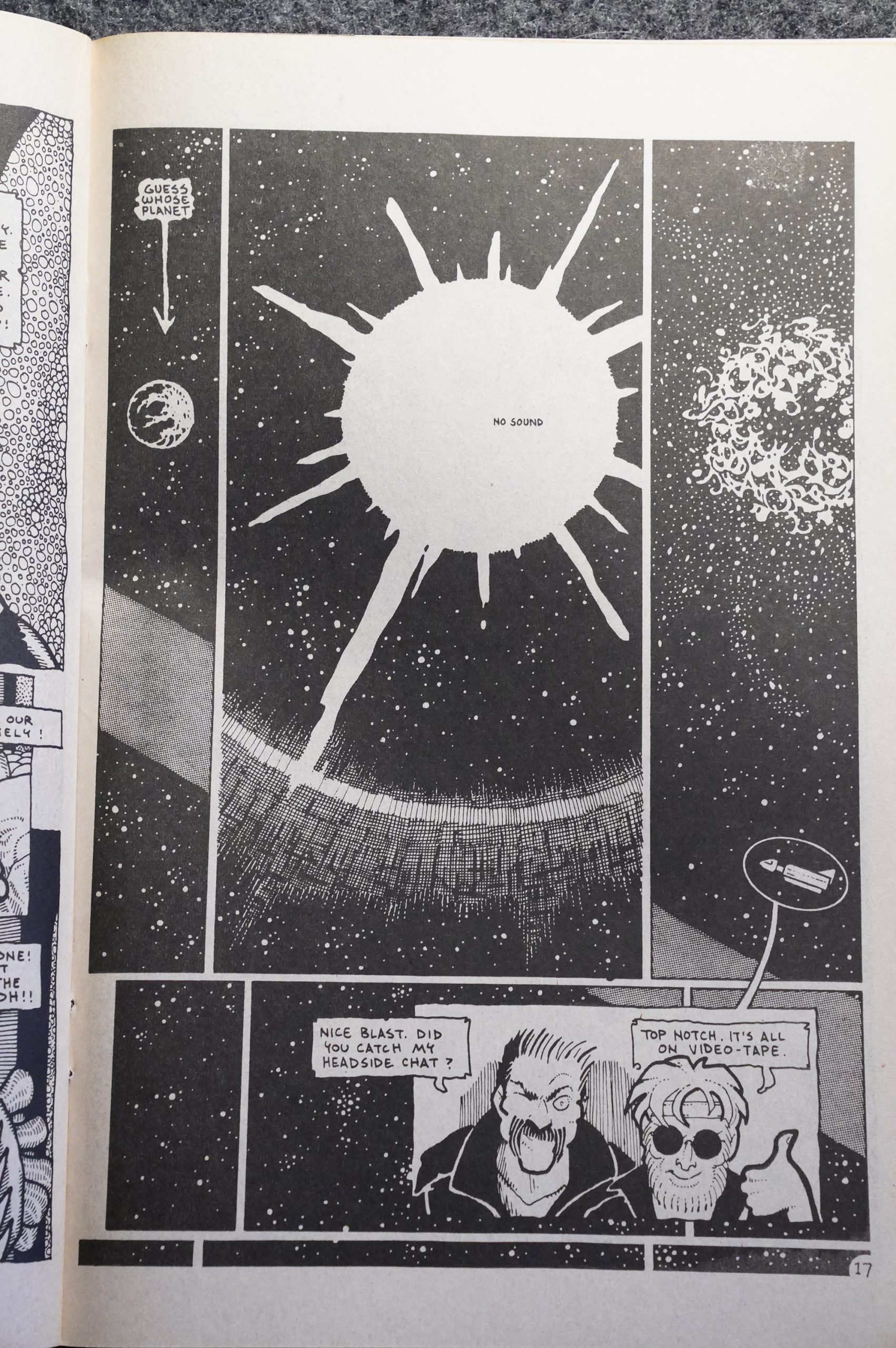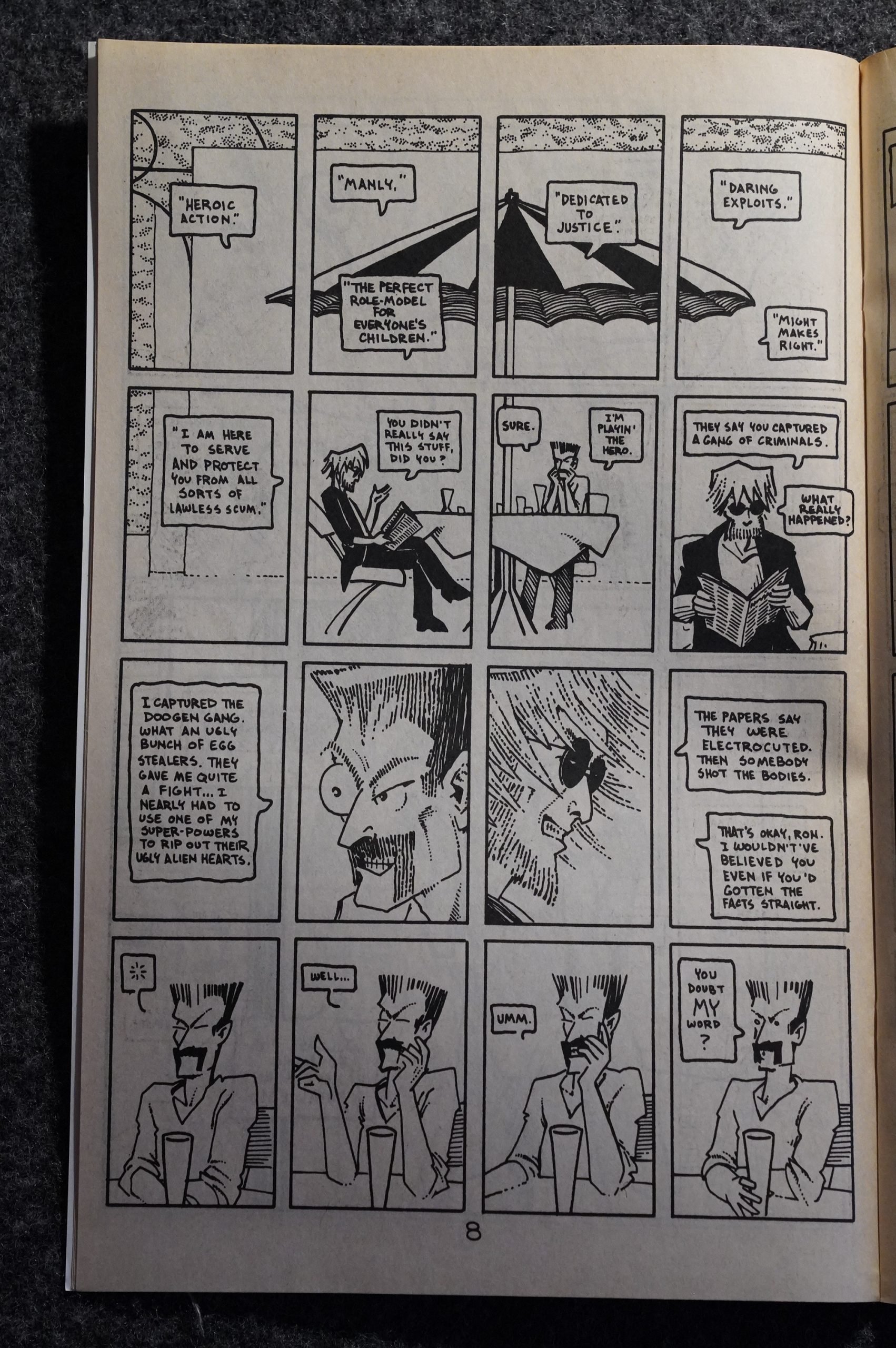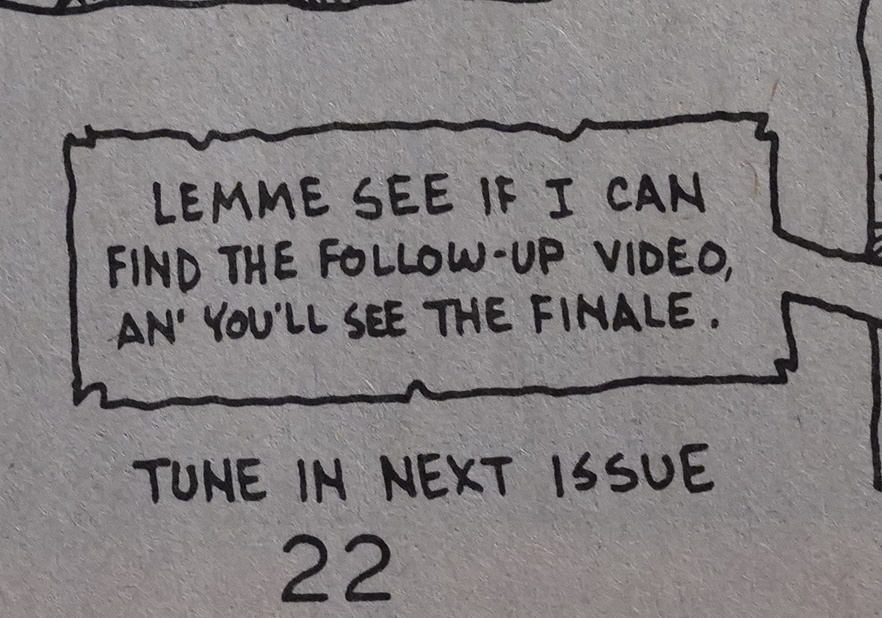Those Annoying Post Bros. (1985) #1-18
by Matt Howarth and others
As a teenager, I read first few issues of this series, but found the nihilistic over-the-top violence off-putting, so I stopped buying it. I have, however, continued to pick up issues now and then, and over the years I seem to have accrued a pretty complete run (and I then bought the remaining few issues for this blog series).
But this is the first time I’m reading Post Bros in sequence… Perhaps I’ll like it more now that I’m all hardened and cynical and oh so world weary? Let’s read the first three pages together:
Yeah, it’s still a lot.
The Post Bros concept is exhilarating and offensively stupid at the same time: There’s this infinite city, Bugtown, where people who die regenerate after a couple of days. The Post Bros live in this city, and they’re able to skip between a number of realities (usually described as mind-bogglingly infinite, but as the story needs dictate, sometimes not so infinite).
The titular Bros are totally psychopathic, and will kill and torture (but apparently not rape?) at the drop of a hat. Here’s the moronic part (and read this in Comic Guy’s voice): The series is basically a number of capers where the Bros go off looking for stuff to steal, because… they need… money? Yes, it’s as stupid as that: These guys can teleport and shift between an infinite number of realities, but they spend most of their time trying to steal things so they can make money.
If Howarth had tweaked this a little bit, saying that the Bros’ motivation is just, like, that they like going on capers, that’d be no problem, but he doesn’t, so…
It’s just a head-scratcher.
The reason I’ve kept on picking up issues of Post Bros even if it’s all a bit hard to take (both the “fun” edge lord torture bits and the base premise) is that Howarth has a few things going for him: His artwork is so much fun to look at. His endless supply of plausible-seeming but odd aliens is wonderful. Howarth is also pretty funny, and some of the plots are genuinely fun and interesting (but the Keif Llama stories are better).
And then there’s the artwork, which I absolutely love. It’s so organic and obsessive — especially in this period. His artwork in the early 80s was a bit rough, and later he cut down on the details a lot, but here everything is just meticulous.
Remember that reality-shifting thing? It’s not just that they can travel to other realities, but they can “shift in” other versions of themselves. Yes, that makes no sense, but you get a lot of cute gags out of it. The problem with this is that there’s then really no… consequence to anything much: If there’s a problem, they can just shift into whatever.
Howarth works around this by just not mentioning it as a possibility unless they’re actually shifting. It’s the “SHHH! DON”T THINK!” method of storytelling.
But I mean… you get gags like this, so…
Howarth does the colouring on the covers consistently in this time-consuming manner: Instead of, say, colouring with watercolours or whatever and then scanning and separating, he draws four “layers” (or three, as in this case, since there’s no black here), one for each of CMYK, I guess. And then he just had to imagine how the colours would end up looking when printing, because all the layers are done in black on white, of course.
An insanely time-consuming and error-prone method, but it looks striking and it’s cheap: You don’t need to do the colour separations; they’re ready to be sent to the printer as is.
Howarth is into experimental electronic music, and several of the characters are in a band, so we get fun stuff like the liner notes from their latest album.
Howarth has also made a bunch of covers to a series of imaginary 7″ singles. I really, really wanted to buy these as a teenager, but I couldn’t really justify spending ALL THAT MONEY on something so frivolous.
Stupid me!
Heh. That’s a cool Coil EP.
So, yeah, there’s a lot of music references in here. Here we have The Walking Heads.
But, OK, the violence. The endless references to “cool” mass murderers and torture and stuff. Here we have Ron Post at the Ed Gein restaurant.
With all these realities going around, if you guessed that Howarth would just cop out sometimes instead of writing a proper end, you’d be correct… but he doesn’t really do it a lot.
… but it’s like Howarth is saying “ok, that was fun and bratty, but a bit lame”, so he then adds a new ending. It’s fun.
Oh, I didn’t mention that the first four issues were co-written by Lou Stathis.
Patricia Jeres joins as an editor, and… here’s a picture she’s taken?
I wondered whether the book would take a radically different direction once Stathis was out, but not really. But the fifth issue has a fun structure at least: We get two storylines running in parallel.
And I like these tiny meta touches.
You have to admire Howarth’s (or Jeres’) absolute refusal to discuss whether the atrocities in Post Bros are appropriate, or whether Howarth is trying to like say anything with them, or… well… anything. “Bad boys do bad things.”
Wow, that’s blurry. Anyway, Seth writes in to tell Howarth how much he likes the baby drop-kicking scene.
But if you were to discuss the violence on display here, perhaps this issue is a good one to try to say something. The brothers are looking for “fun”.
So they basically stage a pre-enactment of Funny Games.
They don’t really torture anybody that much — they scare the shit out of them, beat some of them up a bit, and then watch a nuclear war start. (That’s the reason for the home invasion: The house had the best seats to watch the bombs fall.)
Is this hilarious? Is it “outrageous”? Do bros fist pump and go “dude! it’s so brutal!” Is it a commentary on today’s brutal late-stage capitalist society? Are we meant to loathe the bros or find them kinda fascinating?
Cosey Fanni Tutti writes in to say that she’s a fan.
After a half dozen 32 page issues, Howarth slims down the page count to 24, and uses just 18-20 pages per issue on the main storyline. His artwork also becomes more sloppy; not as obsessive, with plenty of panels where the main characters float in a white void.
He also experiments with using zip-a-tone for one issue (I’m guessing this is also as a labour saving device), and it looks pretty bad: His artwork is so organic that the mechanical tone sits oddly on the page.
The cover colouring is still spiffy, though: Look at all those details in the blue layer. So distinctive.
We also get backup features written by Howarth, but with artwork by others (here’s Dan Steffan). The characters just don’t look… right…
“Intrinsically cruel”.
Howarth also drops in some shorter bits reprinted from elsewhere (here’s a Subgenius thing). It’s fun to see these pieces, but few of them are, like, actually good.
*sigh* Intrinsically cruel? Or just sophomoric?
Probably more the latter.
The thing is: I wasn’t bored while reading these comics. They are inventive, and you genuinely don’t know where they’re going. Sure, a few of them are shaggy dog stories, going nowhere (endings are a problem for Howarth), but they have a wild-eyed … charm … going that’s hard to deny.
But then again, there’s stories like this, where the Bros try to kidnap the same woman from several different realities, and end up accidentally (or not) killing her a lot. As Ron almost says — the stakes get really low when you have an infinite number of tries to get things right. Howarth seems to realise his mistake, because in this story one of the characters says that there’s a limited number of world where this woman exists… which is understandable, but lazy of Howarth.
(I love the Caroline’s hair up there. I mean, it makes no sense if you try to envision it as a real hairstyle, but on paper, in these pages, it’s so natural.)
The gag here is that they’re not kidnapping (and killing) this woman a lot because she’s of any particular interest: She’s just a friend of the daughter of a guy they want to blackmail… so they kidnap her, torture her on tape, and show the tape to that guy as a way of saying “if you don’t do what we want, we’ll torture your daughter like we tortured this woman” (with cattle prods and a chainsaw and cannibalism, apparently). So it’s a fridging twice removed, and the sheer tastelessness of this all is…
I think I was right to ditch this series as a teenager?
Howarth start including his comic strip form music reviews here — they were a staple in the sister Savage Henry title, which I’ll be re-reading in a few days.
The final two Vortex issues feature what was supposed to be the opening issues of the Vortex series, but were held back because Stathis and Howarth didn’t think it was a good place to start. And reading these, I think they were right: They’re pretty weak issues.
But I do love that explosion.
Howarth usually doesn’t do much with formal comics play, but this is a pretty fun page… even though it doesn’t quite work: The segue from one-image-divided-into-panels to a normal panel-as-time thing isn’t completely satisfying.
And then the series is over… at Vortex. Howarth took the series to Rip Off, and then it went to Aeon, and possibly other publishers. There’s over 60 issues available, and I’ve got about two thirds of the remaining ones.
If I remember correctly, the Bros mellow out a bit? I may be totally off on that, though; I haven’t read the issues since the 90s.
Howarth has continued the series since, and you can buy a bewildering quantity of stuff from Howarth’s site. A lot of it is available as PDFs only — I am tempted to buy it all, really.
But what did the critics think, if anything? Let’s search a bit…
Lou Stathis writes a letter to The Comics Journal #111, page 30:
[…]
Then there’s the bit on Bill Marks and
Vortex Comics in #101 begging me to stuff my
two cents in. First, regarding the business that
seems to have it all—the Hernandezes
and others seem to have read the editorial in
Mr. X to mean that they were unprofes-
sional. Hunh? The gist I got from the thing
was that they were too busy. I guess that can
interpreted to mean that “they were unable
to meet their professional commitments” (as
you guys put it), which can then be stretched
to imply some level of unprofessionalism, but
that requires an awful lot of in-reading to draw
that inference. Ain’t nothing wrong with being
unable to churn out material fast enough to
meet a publisher’s needs (happens all the time
in the comics biz, and pretty frequently around
this house as well), and no reason for anybody
to raise their hackles over such a characteriza-
tion. Touchy, touchy.
The bigger issue here, though, is the allega-
tion Of Wrtex’s payment problems. Such prob-
lems do exist all right, as they do throughout
the independent publishing realm—comics,
magazines, books, recordings, all of it. I’ve
known Bill Marks for a bit over two years, and
have been doing business with him for about
half that time, and I haven’t had any real
“problems” With him. Yeah, sometimes
haven’t been paid When I hoped to be, but late
payment is something a freelancer learns to
expect, and I have eventually collected
everything Owed me Without much trouble
(more than I can say about some publishers
I’ve worked for). Part of the reason for that
is, I urote the contract that Matt Howarth and
I have With Vortex for Those Annoying Post
Bros., and so “r it has been That the
Hernandezes’ Mr. X contract had no payment
schedule in it is absurd to me—that’s precisely
what a contract is all about (and if they’d
followed Bill’s advice and consulted a lawyer,
they would’ve been told that right away). Con-
tracts exist to spell but specifically the Obliga-
tions and compensations agreed to by all sign.
ing parties. It is a worst case scenario that
prepares for the total breakdown Of civilized
discourse Extween the docurnents’s signatories.
As they admit, the Herna deaes were naive
and had no experience wit contracts. hap-
pen to have lots Of experience—from my time
as an editorial assistant at Dell Books, through
a brief fling at agenting, my years at HM,
numerous self-numerous self-negotiated deals
for my own novels, articles, stories, and scripts,
as well as consultations with friends in the
comics, bmk, magazine, and recording indus-
ries. They are boring and tedious things, but
an integral part of the business Of art, and if
you care at all.about what happens to your
work and whether you’re going to be ade-
quately compensated, you’ve got to pay close
attention (or else pay someone with expertise
to pay attention for you). TO stumble into
something blind and then cry “foul” when it
doesn’t go the way you though it would strikes
me as more than naive—it’s foolish.
This is in reference to Bill Marks not paying the Hernandez brothers for their work on Mister X. Stathis seems like a total douchecanoe, doesn’t he?
Gary Groth replies in The Comics Journal #111, page 31:
What is this, Ethics in the Publishing profes-
Sion According to Rambo? In other words, accor•
ding to Stathis, any artist young or naive or trusting
enough to let an unethical, greed-crazed publisher
take advantage of him gets what he deserves, and
if the artist has the audacity to whine about it
later, he’s a sap and a loser. It’s a dog-eat-dog world
out there, after all, and publishers have a moral
prerogative to screw artists, and if artists have the
audacity to complain about it, by Gr_kå, they’ll hear
from Lou Stathis. There are two kinds of factions
in this world, the strong and the weak, and the
weak can just bloody well sit back and take it
like men.
Perhaps that’s a better way to put it.
(Stathis didn’t last long at Vortex, but I guess he wrote this letter during the months he was there.)
Richard S. McEnroe writes in Amazing Heroes #144, page 21:
Ron and Russell Post, the infamous
Annoying Post Brose, remain consis-
tently and respectively an unfortunate-
ly impulsive twelv?-year-old sadist
trapped in the body of a thirty-year-
old Doberman pinscher and a laid-
back sociopath convinced of his
intellectual superiority over little
brother Ron because he doesn’t drool
when he giggles with malicious glee.
Cerebus the Aardvark would be con-
sidered backward in their company
(throwing babies into crowds is
something they got over when they
were six years old the second time
around) and Wolverine would be con-
sidered needlessly intellectual—
‘violence is fun and easy,’ would be
the Post Bros. credo; at least it would
if they thought that far ahead before
opening fire—and they react to every-
thing the world(s) can throw at them
with the same cheerful, unflinching
psychopathology. They are the comic-
book fascination with violent excess
taken to its illogical extreme, and
rendered surreal in the process.
Is it, though? Is it?
When reality can change at the
literal drop of a hat, the trick becomes
how well you can juggle them—and
Matt Howarth keeps them spinning in
all three rings. I can’t recommend
them enough.
I googled a bit to see if I could find any reviews of Post Bros, and… nope? That’s just weird. You’d think there’d be several rabid fans with their own web sites, but if so, they’re not turning up on the first three pages of Google.
This blog post is part of the Into the Vortex series.
